LIEBHERR Combined Fridge-Freezer Operating Instructions

1 Аppliance at a glance
1.1 Overview of the appliance and equipment
Note
- Place food inside the appliance as shown in the diagram. This allows the appliance to save energy during operation.
- Shelves, drawers and baskets are arranged for optimum energy efficiency on delivery
Fig. 1
- Controls
- Door rack, adjustable*
- Bottle shelf*
- Vegetable crisper
- Coldest zone
- Drain opening
- Shelf, adjustable
- Egg tray
- Type plate
- Freezer drawer
- VarioSpace
- Ice cube tray
- Front adjustable feet
- Transport handles
- Bottle rack*
* Depending on model and options
1.2 Appliance range of use
Intended use
The appliance is only suitable for refrigerating food in a domestic or domestic-like environment.
This includes, for example, using
- in staff kitchens, bed and breakfast establishments,
- by guests in country houses, hotels, motels and other accommodation,
- for catering and similar services in the wholesale trade.
The appliance is not suitable as a built-in unit.
All other types of use are not permitted.
Foreseeable misuse
The following applications are expressly prohibited:
- Storing and refrigerating medicines, blood plasma, laboratory preparations or similar substances and products based on the Medical Device Directive 2007/47/EC
- Use in areas at risk of explosions
- Use on moving substrates, such as ships, rail travel or aeroplanes
- Storing live animals
Misusing the appliance may lead to damage to the goods stored or they may spoil.
Climate classifications
Depending on its climate class, the appliance is designed for operation within certain ambient temperature limits. The correct climate rating for your appliance is indicated on the type plate.
Note
- Keep to the specified ambient temperatures in order to guarantee that the appliance works properly.
| Climate classification | for ambient temperatures of |
| SN | 10 °C up to 32 °C |
| N | 16 °C up to 32 °C |
| ST | 16 °C up to 38 °C |
| T | 16 °C up to 43 °C |
1.3 Conformity
The refrigerant circuit has been tested for leaks. This appliance complies with the applicable safety stipulations and with directives 2014/35/EU, 2014/30/EU, 2009/125/EG, 2011/65/EU and 2010/30/EU.
1.4 EPREL database
Details about energy labelling and ecodesign requirements will be available on the European product database (EPREL) from 1st March 2021. You can access the product database at the following link: https://eprel.ec.europa.eu/ You will be asked to enter the model ID. You can find the model ID on the nameplate.
1.5 Installation dimensions
Fig. 2

1.6 Saving energy
- Pay attention to good ventilation. Do not cover ventilation holes or grids.
- Always keep the fan air slits clear.
- Do not install the appliance in direct sunlight, next to an oven, radiator or similar.
- Energy consumption is dependent on the installation conditions, e.g. ambient temperature (see 1.2 Appliance range of use) . A warmer ambient temperature can increase the energy consumption.
- Open the appliance for as short a time as possible.
- The lower the temperature is set, the higher the energy consumption.
- Sort food before arranging (see Appliance at a glance).
- Store all food well packaged and covered. A build up of frost is avoided.
- Only take food out for as long as necessary so that it doesn’t warm up too much.
- Inserting hot food: let it cool to room temperature first.
- Thaw frozen food in the refrigerator.
- If you intend to be on holiday for a long time empty the refrigerator and switch it off.
- Dust deposits increase energy consumption:
- For refrigerators with heat exchangers dust the metal grid on the back of the appliance once a year. Fig. 10
2 General safety information
Danger for the user
- This device can be used by children and people with impaired physical, sensory or mental abilities or with a lack of experience and knowledge provided that they are supervised or have received instruction in the safe use of this device, and about the resulting hazards. Children must not play with this appliance. Cleaning and user maintenance work must not be carried out by children without adult supervision. Children aged between 3 and 8 are allowed to load and unload the appliance. Children below the age of 3 must be kept away from the appliance unless they are under continuous adult supervision.
- When disconnecting the appliance from the supply, always take hold of the plug. Do not pull the cable.
- In the event of a fault pull out the mains plug or deactivate the fuse.
- Do not damage the mains power cable. Do not operate the appliance with a defective mains power cable.
- Have any repairs to or intervention in the appliance, and any change of the mains power cable, carried out by the customer service only or by other specialised personnel trained for the purpose.
- Only assemble, connect and dispose of the appliance according to the instructions.
- Please keep these instructions in a safe place and pass them on to any subsequent owners.
Fire hazard:
- The coolant used (information on the model plate) is eco-friendly but also flammable. Any leaking coolant may ignite.
- Do not damage the refrigerant circuit pipes.
- Do not handle ignition sources inside the appliance.
- Do not use any electrical appliances in the interior (e.g. steam cleaners, heaters, ice cream maker etc.).
- If refrigerant escapes: remove any naked flames or sources of ignition from the leakage area. Ventilate the room well. Notify the after-sales service.
- Do not store explosives or sprays using combustible propellants such as butane, propane, pentane, etc. in the appliance. To identify these spray cans, look for the list of contents printed on the can, or a flame symbol. Gases possibly escaping may ignite due to electrical components.
- Keep burning candles, lamps and other items with naked flames away from the appliance so that they do not set the appliance on fire.
- Please be sure to store alcoholic drinks or other packaging containing alcohol in tightly closed containers. Any alcohol that leaks out may be ignited by electrical components.
Danger of tipping and falling:
- Do not misuse the plinth, drawers, doors etc. as a step or for support. This applies particularly to children.
Danger of food poisoning:
- Do not consume food which has been stored too long.
Danger of frostbite, numbness and pain:
- Avoid prolonged skin contact with cold surfaces or refrigerated/frozen goods or take protective measures, e.g. wear gloves.
Danger of injury and damage:
- Hot steam can lead to injury. Do not use electrical heating or steam cleaning equipment, open flames or defrosting sprays to defrost.
- Do not use sharp implements to remove the ice
Danger of crushing:
- Do not hold the hinge when opening and closing the door. Fingers may get caught.
Symbols on the appliance:
 The symbol can be located on the compressor. It refers to the oil in the compressor and indicates the following danger: Swallowing or inhaling can be fatal. This is only relevant for recycling. There is no danger in normal operation.
The symbol can be located on the compressor. It refers to the oil in the compressor and indicates the following danger: Swallowing or inhaling can be fatal. This is only relevant for recycling. There is no danger in normal operation.
 This symbol is found on the compressor and indicates the danger of flammable materials. Do not remove the sticker.
This symbol is found on the compressor and indicates the danger of flammable materials. Do not remove the sticker.
 A sticker to this effect may be applied to the rear of the appliance. It refers to the foampadded panels in the door and/or the housing. This is only relevant for recycling. Do not remove the sticker.
A sticker to this effect may be applied to the rear of the appliance. It refers to the foampadded panels in the door and/or the housing. This is only relevant for recycling. Do not remove the sticker.
Please observe the specific information in the other sections

3 Controls and displays
3.1 Operating controls
Fig. 11
- On/Off button
- Ventilation button
- Adjustment button, fridge section
- Temperature display, fridge section
- Temperature display, freezer section
- Adjustment button, freezer section
- SuperFrost button
- Alarm button
- On/Off button, freezer section
- SuperFrost symbol
- Alarm symbol
- Sabbath Mode symbol
- Menu symbol
- Child lock symbol
- Ventilation symbol
3.2 Temperature display
The following are displayed in normal mode:
- the set freezer temperature
- the set fridge temperature The temperature display on the freezer section flashes if/when:
- the temperature setting is being changed
- the temperature is not yet sufficiently cold after switching on
- the temperature has risen by several degrees
4 Putting into operation
4.1 Transporting the appliance
- Transport the appliance in a packed condition.
- Transport the appliance upright.
- Do not transport the appliance without assistance.
4.2 Installing the appliance
 WARNING
WARNING
Fire hazard due to dampness!
If live parts or the mains lead become damp this may cause short circuits.
- The appliance is designed for use in enclosed areas. Do not operate the appliance outdoors or in areas where it is exposed to splash water or damp conditions.
 WARNING
WARNING
Risk of fire due to short circuit!
If the mains cable/connector of the appliance or of another appliance touch the rear of the appliance, the mains cable/ connector may be damaged by the appliance vibrations, leading to a short circuit.
- Stand the appliance so that it is not touched by connectors or main cables.
- Do not plug the appliance or any others into sockets located near the rear of the appliance.
 WARNING
WARNING
Fire hazard due to refrigerant!
The coolant used is eco-friendly but also flammable. Any leaking coolant may ignite.
 WARNING
WARNING
Fire hazard and danger of damage!
- Do not place appliances emitting heat e.g. microwaves, toasters etc. on the appliance!
 WARNING
WARNING
Blocked ventilation openings pose a risk of fire and damage!
- Always keep the ventilation openings clear. Always ensure that the appliance is properly ventilated!
NOTICE
Risk of damage due to condensate!
- Do not install the appliance directly alongside a further refrigerator/freezer.
Note
If you have several appliances next to one another, leave a gap of 100mm between appliances. Otherwise condensation will build up between the units, fig.13.
- In the event that the appliance is damaged, contact the supplier immediately before connecting to the mains.
- The floor at the site must be flat and level.
- Do not install the appliance in a location where it is exposed to direct radiation of the sun, next to a cooker, heater and similar.
- Always stand the appliance backed directly to the wall using the enclosed wall spacers (see below).
- The appliance may be moved only when it is empty.
- The surface supporting the appliance must be at the same level as the surrounding floor.
- Do not install the appliance without assistance.
- The more coolant there is in the appliance, the larger the room in which the appliance is installed must be. If the room is too small, any leak may create a flammable mixture of gas and air. For each 8 g of coolant the installation space must be at least 1 m3. Information on the coolant is on the model plate inside the appliance.
- Detach the connecting cable from the rear of the appliance, removing the cable holder at the same time because otherwise there will be vibratory noise!
- Remove the protective film from the outside of the appliance.*
- Remove all transit supports.
The spacers supplied with some appliances must be used to achieve the stated energy consumption. These will extend the depth of the appliance by approx. 35 mm. The appliance is fully functional if the spacers are not used, but does have a slightly higher energy consumption.
- Fig. 9 In the case of an appliance with enclosed wall spacers, mount the wall spacers on the back of the appliance at the top left and right.
- Dispose of packaging material. (see 4.5 Disposing of packaging)
 CAUTION
CAUTION
Risk of injury or damage from the appliance tipping or the door falling open!
If the additional adjustable foot on the base support is not correctly positioned on the floor, there is a risk of the door falling open or the appliance tipping. This can lead to injury or property damage.
- Unscrew the additional adjustable foot on the support until it reaches the floor.
- Then turn it another 90°.
- Fig. 4 Align the appliance so that it stands firmly and on a level by applying the accompanying spanner to the adjustable height feet (A) and using a spirit level. Then support the door: Extend the adjustable foot at the turn hinge (B) until it rests on the floor and then make a further 90° turn.
Note
- Clean the appliance (see 6.2 Cleaning the appliance).
If the appliance is installed in a very damp environment, condensate may form on the outside of the appliance.
- Always see to good ventilation at the installation site.
4.3 Changing over the door hinges
You can change over the door hinges if necessary:
 see assembly instructions provided.
see assembly instructions provided.
Ensure that the following tools are to hand:
- Torx® 25
- Screwdriver
- Cordless screwdriver, if necessary
- Second person for fitting work, if needed
Note
- Remove any food from the door racks before removing the door, so that no food falls out.
 CAUTION
CAUTION
Risk of injury if the door tips!
- Take good hold of the door.
- Set down the door carefully.
 WARNING
WARNING
Risk of injury due to the door dropping out!
If the bearing parts are not screwed into place firmly enough, the door may drop out. This may lead to severe injuries. What is more, the door may not close and therefore the appliance may fail to cool properly.
* Depending on model and options
- Screw the turn hinges firmly into place with 4 Nm.
- Check all of the screws and retighten if necessary.
4.4 Insertion into a row of kitchen units
The appliance can be built into kitchen units.
 see assembly instructions provided.
see assembly instructions provided.
Ventilation requirements:

x For appliances supplied with wall spacers, the measurement
increases by 35 mm (see 4.2 Installing the appliance).
The appliance may protrude further, depending on the depth of the kitchen units and the use of wall spacer brackets.
NOTICE
Risk of damage to the appliance due to overheating with insufficient ventilation!
The compressor may be damaged with insufficient ventilation.
- Ensure sufficient ventilation.
- Observe the ventilation requirements.
4.5 Disposing of packaging
 WARNING
WARNING
Danger of suffocation due to packing material and plastic film!
- Do not allow children to play with packaging material.
 The packaging is made of recyclable materials:
The packaging is made of recyclable materials:
- corrugated board/cardboard
- expanded polystyrene parts
- polythene bags and sheets
- polypropylene straps
- nailed wooden frame with polyethylene panel*
- Take the packaging material to an official collecting point.
4.6 Connecting the appliance
NOTICE
Failure to connect properly
Damage to the electronics.
- Do not use a standalone inverter.
- Do not use an energy saving plug.
 WARNING
WARNING
Failure to connect properly Fire.
- Do not use an extension cable.
- Do not use distributor blocks.
The type of current (alternating current) and voltage at the installation site have to conform with the data on the type plate (see Appliance at a glance).
The socket must be properly earthed and fused. The tripping current for the fuse must be between 10 A and 16 A.
The socket must be easily accessible so that the appliance can be quickly disconnected from the supply in an emergency. It must be outside the area of the rear of the appliance.
 Check the electrical connection.
Check the electrical connection.- Plug in the power plug.
4.7 Switching on the appliance
Note
- To switch on the entire appliance it is necessary only to switch on the freezer compartment. In so doing, the refrigerator compartment is automatically switched on as well.
The appliance should have been operating for about 2 hours before you stock it with frozen food. Only place frozen goods in the freeze compartment once the temperature display shows at least -18°C.
4.7.1 Switching on the freezer compartment
- Press On/Off button for the freezer section Fig. 11 (9).
- The appliance is switched on. The temperature display shows the set temperature. The temperature display for the freezer section and the alarm symbol flash until the temperature is cold enough.
4.7.2 Switching on the refrigerator compartment
Note
- When the refrigerator compartment is switched on, the freezer compartment is automatically switched on as well.
If the refrigerator compartment was switched off (e.g. with an extended absence due to holiday), this can be switched on again separately.
- Press On/Off button for the fridge section Fig. 11 (1).
- The interior light comes on when the door is open.
- The temperature displays light up. Refrigerator compartment and freezer compartment are switched on.
5 Control
5.1 Child proofing
 The child-proofing function enables you to make sure that the appliance is not inadvertently switched off by playing children.
The child-proofing function enables you to make sure that the appliance is not inadvertently switched off by playing children.
5.1.1 Setting the child lock
To switch on the function:
- Activate the setting mode: Press SuperFrost button Fig. 11 (7) for approx. 5 seconds.
- The menu symbol Fig. 11 (13) is shown on the display.
- S flashes on the display.
- Using the adjustment button for the freezer section Fig. 11 (6) select c.
- Briefly confirm with the SuperFrost button Fig. 11 (7).
- c1 appears on the display.
- Briefly confirm with the SuperFrost button Fig. 11 (7).
- The child lock symbol Fig. 11 (14) lights up on the display.
- c flashes on the display.
- The child lock function is switched on.
To cancel setting mode: - Briefly press the On/Off button for the freezer section Fig. 11 (9).
-or-
- wait 5 min.
- The temperature display shows the temperature again.
To switch off the function:
- Activate the setting mode: Press SuperFrost button Fig. 11 (7) for approx. 5 seconds.
- The menu symbol Fig. 11 (13) is shown on the display.
- c flashes on the display.
- Briefly confirm with the SuperFrost button Fig. 11 (7).
- c0 appears on the display.
- The child lock symbol Fig. 11 (14) goes out.
- c flashes on the display.
- The child lock function is switched off.
To cancel setting mode:
- Briefly press the On/Off button for the freezer section Fig. 11 (9).
-or-
- Wait 5 min.
- The temperature display shows the temperature again.
5.2 Door alarm
 For the fridge and freezer compartments
For the fridge and freezer compartments
An audible warning sounds if the door is open for longer than 60 seconds.
The audible warning stops automatically when the door is closed.
5.2.1 Muting the door alarm
The audible alarm can be muted when the door is open. The sound switch-off function is active as long as the door is left open.
- Press alarm button Fig. 11 (8).
5.3 Temperature alarm
 The audible alarm sounds if the freezer temperature is not cold enough.
The audible alarm sounds if the freezer temperature is not cold enough.
The temperature display and the alarm symbol flash at the same time.
The cause of the temperature being too high may be:
- warm fresh food was placed inside
- too much warm ambient air flowed in when rearranging and removing food
- power failure for some time
- the appliance is faulty
The audible alarm is automatically silenced and the alarm symbol goes out when the temperature is sufficiently cold again. If the alarm state persists: (See Malfunction).
Note
Food may be spoilt if the temperature is not cold enough.
- Check the quality of the food. Do not consume spoiled food.
5.3.1 Muting the temperature alarm
The audible alarm can be muted. When the temperature is sufficiently cold again, the alarm function is active again.
- Press alarm button Fig. 11 (8).
- The audible alarm is silenced.
5.4 Sabbath Mode
 This function meets the religious requirements on the Sabbath or Jewish feast days. When Sabbath mode is on some of the electronic control functions are switched off. After setting Sabbath mode you no longer need to worry about indicator lamps, figures, symbols, displays, alarm messages and fans. The thawing cycle only works for the specified time without taking account of fridge use. After a power cut the appliance automatically switches back to Sabbath mode.
This function meets the religious requirements on the Sabbath or Jewish feast days. When Sabbath mode is on some of the electronic control functions are switched off. After setting Sabbath mode you no longer need to worry about indicator lamps, figures, symbols, displays, alarm messages and fans. The thawing cycle only works for the specified time without taking account of fridge use. After a power cut the appliance automatically switches back to Sabbath mode.
There is a list of Star-K certified appliances at www.star-k.org/appliances.
 WARNING
WARNING
Danger of food poisoning.
If a power cut occurs when Sabbath mode is enabled, this message is not saved. Once the power is restored the appliance continues to work in Sabbath mode. When this mode is over no message about the power cut is displayed on the temperature display. If a power cut occurred during Sabbath mode:
- Check the food for quality. Do not eat the food if it has thawed.
- All functions are blocked until Sabbath Mode is switched off.
- If functions such as SuperFrost, SuperCool, ventilation etc. are selected when Sabbath mode is switched on, they remain switched on.
- No audible signals are emitted and the temperature display does not indicate any warnings or settings (such as a temperature alarm or door alarm).
- The internal light is off.
5.4.1 Setting Sabbath Mode
- Activate the setting mode: Press SuperFrost button Fig. 11 (7) for approx. 5 seconds.
- S flashes on the display.
- The menu symbol Fig. 11 (13) lights up.
- In order to call up the Sabbath Mode function: Press SuperFrost button Fig. 11 (7) briefly.
If S1 appears on the display:
- To switch on Sabbath Mode, press the SuperFrost button
5.4.1 Setting Sabbath Mode
- Activate the setting mode: Press SuperFrost button Fig. 11 (7) for approx. 5 seconds.
- S flashes on the display.
- The menu symbol Fig. 11 (13) lights up.
- In order to call up the Sabbath Mode function: Press SuperFrost button Fig. 11 (7) briefly.
If S1 appears on the display:
- To switch on Sabbath Mode, press the SuperFrost button Fig. 11 (7) briefly.
- To switch off Sabbath Mode, press the SuperFrost button Fig. 11 (7) briefly.
If S0 appears on the display:
- Briefly confirm with the SuperFrost button Fig. 11 (7).
- Deactivate the setting mode: Press On/Off button for the freezer section Fig. 11 (9).
-or-
- wait 5 min.
- The Sabbath Mode symbol is displayed in the temperature display, as long as Sabbath Mode is active.
- SabbathMode switches off automatically after 120 hours if it has not already been switched off manually.
5.5 Refrigerator compartment
The natural circulation of air in the refrigerator compartment results in zones differing in temperature. It is coldest directly above the vegetable drawers and at the rear wall. It is warmest at the top front of the compartment and in the door.
5.5.1 Food refrigeration
Note
The energy consumption increases and the cooling performance decreases if the ventilation is inadequate.
- Always keep the air slits of the fan free.
- Store perishable food such as ready-to-serve dishes, meat products and sausages in the coldest zone. Place butter and preserves in the upper area and in the door (see Appliance at a glance).
- Use recyclable plastic, metal, aluminium and glass containers and cling film for wrapping.
- Always store raw meat and fish in clean, sealed containers on the bottom shelf of the refrigerator, to prevent them coming into contact with or dripping onto other foods.
- Always store liquids and food which is subject to odour or taste transfer in closed containers or cover them.
- Use the front area of the refrigerator compartment floor only for briefly putting down cooled products, e.g. when rearranging and sorting. However do not leave cooled products there otherwise they may be pushed back or tipped over when the door is closed.
- Do not store food too close together to enable good air circulation.
5.5.2 Setting the temperature
The temperature depends on the following factors:
- the frequency of opening the door
- how long the door is open for
- the room temperature of the installation location
- the type, temperature and quantity of the food
Recommended temperature setting: 5 °C
The temperature can be changed sequentially. When the setting 1 °C is reached, it begins again at 9 °C.
- Call up the temperature function: Press the fridge adjustment button Fig. 11 (3).
- The previously set value is shown flashing in the temperature display.
- Changing the temperature in 1°C increments: Press the fridge adjustment button Fig. 11 (3) repeatedly until the desired temperature is shown on the temperature display.
- During adjustment the value flashes on the display.
- Approx. 5 sec. after the last button press, the new setting is accepted. The interior temperature slowly adjusts to the new value.
* Depending on model and options
5.5.3 Fan
 Cooling by circulating air is recommended:
Cooling by circulating air is recommended:
- at high room temperature (above 33 °C )
- with high humidity
The forced-air cooling uses slightly more energy. To save energy, the fan switches off automatically when the door is open.
Switching on the fan
- Press ventilation button Fig. 11 (2) briefly.
- The ventilation symbol Fig. 11 (15) is shown on the display.
- The fan is active. With some appliances, it only switches on if the compressor is running.
Switching off the fan
- Press ventilation button Fig. 11 (2) briefly.
- The ventilation symbol Fig. 11 (15) goes out.
- The fan is switched off.
5.5.4 Shelves
Moving or removing shelves
Fig. 6
- To completely remove the shelf, observe the sequence of actions indicated.
- Insert shelf with the raised edge at the back pointing upwards.
5.5.5 Door rack
Removing the door rack
Fig. 7
- Remove the rack as shown in the illustration.
5.6 Freezer compartment
You can store frozen food, make ice cubes and freeze fresh food in the freezer compartment.
5.6.1 Freezing food
The rating plate indicates the maximum quantity of fresh food you can freeze within 24 hours (see Appliance at a glance) under “Freezing capacity … kg/24h”.
The maximum load of frozen food for the drawers is 20 kg each.
 CAUTION
CAUTION
Danger of injury due to glass fragments!
Drinks bottles and drinks cans may explode during freezing.
This applies in particular to drinks containing carbon dioxide.
- Do not freeze drinks bottles and drinks cans!
To ensure that food freezes right through, the following quantities should not be exceeded per package:
- Fruit, vegetables, up to 1 kg
- Meat, up to 2.5 kg
- Package food in portions in freezer bags, reusable plastic, metal or aluminium containers.
5.6.2 Storage life

5.6.3 Thawing food
- in the refrigerator compartment
- in the microwave oven
- in a conventional or fan oven
- at room temperature
- Remove only as much food as is required. Use thawed food as quickly as possible.
- Food once thawed should be re-frozen only in exceptional cases.
5.6.4 Setting the temperature
Temperature setting to be recommended: -18 °C
The temperature can be changed continuously. Once the -26 °C setting is reached, it starts again with -16 °C.
- Call up the temperature function: Press the freezer adjustment button Fig. 11 (6).
- The current temperature flashes on the temperature display.
- Press the freezer adjustment button Fig. 11 (6) repeatedly until the desired temperature is displayed.
5.6.5 SuperFrost
 With this function you can freeze fresh food quickly through to the core. The appliance operates with maximum refrigeration.
With this function you can freeze fresh food quickly through to the core. The appliance operates with maximum refrigeration.
The noise of the refrigeration unit may be temporarily louder as a result.
The maximum amount of fresh food which can be frozen in 24 h is indicated on the type plate under “freezing capacity … kg/ 24h”. This amount varies according to the model and climate rating. You have to activate SuperFrost in good time, depending on how much fresh food is to be frozen: about 6 hours before placing the food inside in case of small amounts and about 24 hours in advance in case of the maximum amount of food to be frozen. Wrap produce and spread it out as far as possible. Do not allow produce to be frozen to touch produce that is already frozen to prevent the latter thawing.
You do not have to activate SuperFrost in the following cases:
- when placing frozen food in the freezer
- when freezing up to approx. 2 kg fresh food daily
Freezing with SuperFrost
- Briefly press the SuperFrost button Fig. 11 (7).
- The SuperFrost symbol Fig. 11 (10) is shown on the display.
- The freezing temperature is reduced, and the appliance operates at the maximum freezing capacity.
Note
- Pressing the SuperFrost button can cause the compressor to switch on up to 8 minutes later, thanks to the integrated switch-on delay. This delay increases the service life of the compressor.
In case of a small amount of food to be frozen:
- Wait approx. 6 hours.
In case of the maximum amount of food to be frozen (see type plate):
- Wait approx. 24 hours. u Place packaged food in the top drawers.
- SuperFrost is automatically deactivated after about 65 hours.
- The SuperFrost symbol Fig. 11 (10) goes out when freezing is finished.
- The appliance continues to operate in the energy-saving, normal mode.
5.6.6 Drawers
Note
Insufficient ventilation results in the energy consumption rising and the refrigeration capacity falling.
Appliances with NoFrost:
- Leave the bottom drawer inside the appliance!
- Always keep the inside vents at the rear wall clear!
- Remove the drawers as shown in Fig. 5.
5.6.7 VarioSpace
Fig. 3
You can remove the drawers. This makes space for large freezer items. Poultry, large joints of meat and game, and large bakery goods can be stored and subsequently prepared whole.
- The drawers can each be loaded with max. 20 kg of frozen food.
6 Maintenance
6.1 Defrosting with NoFrost
The NoFrost system automatically defrosts the appliance.
Refrigerator compartment:
The defrosted water is evaporated by the heat of the compressor. Water drops or a thin layer of frost or ice can form on the back wall; this is a completely normal part of the machine’s function.
- Regularly clean the drain opening to allow the water to flow away (see 6.2 Cleaning the appliance).
Freezer compartment:
The moisture condenses on the evaporator, is periodically defrosted and evaporates.
- The appliance does not have to be manually defrosted.
6.2 Cleaning the appliance
Clean the appliance regularly.
 WARNING
WARNING
Risk of injury and damage as a result of hot steam!
Hot steam can lead to burns and can damage the surfaces.
- Do not use any steam cleaners!
NOTICE
Incorrect cleaning damages the appliance!
- Do not use cleaning agents in their concentrated form.
- Do not use any scouring or abrasive sponges or steel wool.
- Do not use any sharp or abrasive cleaning agents, nor any that contain sand, chloride or acid.
- Do not use chemical solvents.
- Do not damage or remove the type plate on the inside of the appliance. It is important for the customer service.
- Do not pull off, bend or damage cables or other components.
- Do not allow any cleaning water to enter the drain channel, ventilation grille or electrical components.
- Please use soft cleaning cloths and a universal pH-neutral cleaning agent.
- Please use soft cleaning cloths and a universal pH-neutral cleaning agent.
- Empty the appliance.
- Pull out the power plug.
- Clean the outer walls and interior surfaces, as well as equipment parts by hand with lukewarm water and a little washing-up liquid.
- Only clean painted side walls by wiping with a soft, clean cloth. In case of heavy soiling, use lukewarm water and a neutral cleaning product.
- Only clean painted door surfaces by wiping with a soft, clean cloth. In case of heavy soiling, use a little water or a neutral cleaning product. Optionally, a microfibre cloth can be used.
- The stainless steel doors are treated with a premium surface finish. Stainless steel care products attack these surfaces.
- Clean the drain opening Fig. 8: If necessary remove deposits with a thin object, such as a cotton bud or similar.
After cleaning:
- Wipe dry the appliance and items of equipment.
- Connect the appliance and switch it on again.
- Switch on SuperFrost (see 5.6.4 Setting the temperature). When the temperature is sufficiently cold:
- Put the food back inside.
* Depending on model and options
6.3 Customer service
Fig. 12
First of all check whether you can eliminate the fault yourself (see Malfunction). If this is not possible, contact Customer Services. You can find the address in the enclosed customer service list.
 WARNING
WARNING
Risk of injury if repair work is not carried out professionally!
- Have any repairs and action – not expressly specified – on the appliance and mains cable carried out by service personnel only. (see 6 Maintenance)
- For the appliance designation Fig. 12 (1), service no. Fig. 12 (2) and the serial no. Fig. 12 (3) refer to the type plate. The type plate is located on the left, inside the machine.
- Inform customer service and describe the fault, appliance designation Fig. 12 (1), service no. Fig. 12 (2) and serial no. Fig. 12 (3).
- This will make it possible to provide fast and accurate service.
- Leave the appliance plugged in until customer service arrives.
- The food will stay cold for longer.
- Pull out the plug (do not tug on the connection cable here) or switch off the circuit breaker.
- For the appliance designation Fig. 12 (1), service no. Fig. 12 (2) and the serial no. Fig. 12 (3) refer to the type plate. The type plate is located on the left, inside the machine.
- Inform customer service and describe the fault, appliance designation Fig. 12 (1), service no. Fig. 12 (2) and serial no. Fig. 12 (3).
- This will make it possible to provide fast and accurate service.
- Leave the appliance plugged in until customer service arrives.
- The food will stay cold for longer.
- Pull out the plug (do not tug on the connection cable here) or switch off the circuit breaker.
7 Malfunctions
Your appliance is designed and manufactured for a long life span and reliable operation. If a malfunction nonetheless occurs during operation, check whether it is due to a handling error. In this case you will have to be charged for the costs incurred, even during the warranty period. You may be able to rectify the following faults yourself:
Normal noises in the appliance:
Running noise due to speed-regulated compressors.
A bubbling or splashing sound from the coolant flowing through the coolant circuit.
A quiet clicking, when the cooling unit (motor) switches itself on and off automatically.
Brief humming noise, slightly louder:
- When the motor switches on, when SuperFrost is switched on, if fresh food has been recently stored or the door has been open for a long period, the freezing capacity automatically increases.
- High ambient temperature (s. 1.2 Appliance range of use)
Deep humming – Noise of air flowing through the fan.
The compressor runs for a long time:
- It switches to a lower speed when it requires a lower cooling capacity, to save energy.
- SuperFrost is switched on.
A LED on the bottom rear of the appliance (at the compressor) flashes regularly every 15 seconds*.
- The inverter is equipped with a diagnostic LED. The flashing is normal.
External surfaces warm. The heat from the cooling circuit is used to avoid condensate.
Faults that you can remedy yourself:
The appliance does not function:
- The appliance is not switched on.
- Plug the plug into the mains socket correctly, check fuse
Vibration noises, if the appliance is not set up firmly on the floor. - Align the appliance with the adjustable feet.
Temperature is not cold enough:
- Appliance door is not fully closed.
- Close appliance door.
- Ventilation and aeration insufficient.
- Clear and clean the ventilation grille.
- High ambient temperature
- see 1.2 Appliance range of use.
- Excessive quantity of fresh food stored without actuating SuperFrost.
- see 5.6.4 Setting the temperature
- The appliance was opened too frequently or for too long.
- Wait to see if the appliance goes back to the required temperature by itself. If not, contact customer services (see maintenance).
- Temperature set incorrectly.
- Set colder and check after 24 hours.
- Appliance is set up too close to a heat source.
- Change the location of the appliance or adjust the heat source.
The interior light does not light up.
- Appliance is not switched on.
- Switch on the appliance.
- The door was open for longer than 15 minutes.
- Interior light switches off automatically if the door stays open for approx. 15 minutes.
Icing up or condensate forming.
- The door seal may have also slipped out of its groove.
- Check the door seal.
With the following faults, contact customer service:
- The door seal is defective or requires replacement for another reason. Door seal exchangeable.
- DEMO is shown in the temperature display.
- LED lighting is defective or the cover is damaged.
 WARNINGS:
WARNINGS:
Risk of injury due to electric shock!
Live parts are located under the cover.
- Have the LED interior light changed or repaired only by the customer service or by specialized personnel trained for the purpose.
Danger of injury by LED lamp!
The light intensity of the LED lighting corresponds to risk group RG 2.
If the cover is defective:
- Do not look into the illumination with optical lenses from the immediate proximity. This can cause injury to the eyes.
8 Decommissioning
8.1 Switching off the appliance
Note
- To switch off the entire appliance you only need to switch off the freezer section. The fridge section is automatically switched off with it.
8.1.1 Switching off the freezer section
- Press On/Off button for the freezer section Fig. 11 (9) for at least 3s.
- The temperature displays are dark. The entire appliance is switched off.
8.1.2 Switching off the fridge section
- Press On/Off button for the fridge section Fig. 11 (1) for at least 3s.
- The interior lighting goes out.
- The temperature display of the fridge section is dark.
Note
- If only the fridge section is to be switched off, e.g. during holiday periods, always make sure that the temperature display for the freezer section is illuminated.
8.2 Taking the appliance out of service
 Empty the appliance.
Empty the appliance.- Switch off the appliance (see “Decommissioning”).
- Unplug the mains plug.
- Clean the appliance (see 6.2 Cleaning the appliance).
- Leave the door open to prevent odour.
9 Disposing of the appliance
 The appliance contains some reusable materials and should be disposed of properly – not simply with unsorted household refuse. Appliances which are no longer needed must be disposed of in a professional and appropriate way, in accordance with the current local regulations and laws.
The appliance contains some reusable materials and should be disposed of properly – not simply with unsorted household refuse. Appliances which are no longer needed must be disposed of in a professional and appropriate way, in accordance with the current local regulations and laws.
Do not damage the disused appliance while removing it from the cooling circuit, in case the coolant (information on the model plate)) or oil inside leaks out.
For Germany:
The appliance can be disposed of free of charge in Class 1 collection containers at your local recycling centre. When purchasing a new fridge/freezer and if your sales area is > 400 m2, the retailer with also take back the old appliance free of charge.
Decommission the appliance:
- Pull out the plug.
- Remove the connection cable from the appliance.
- Cut through the connecting cable.



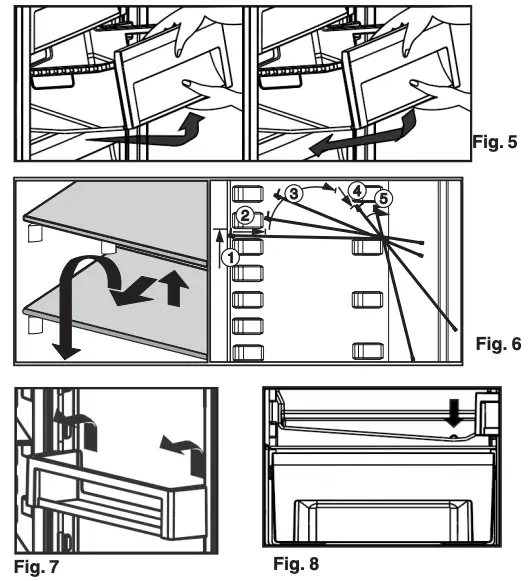
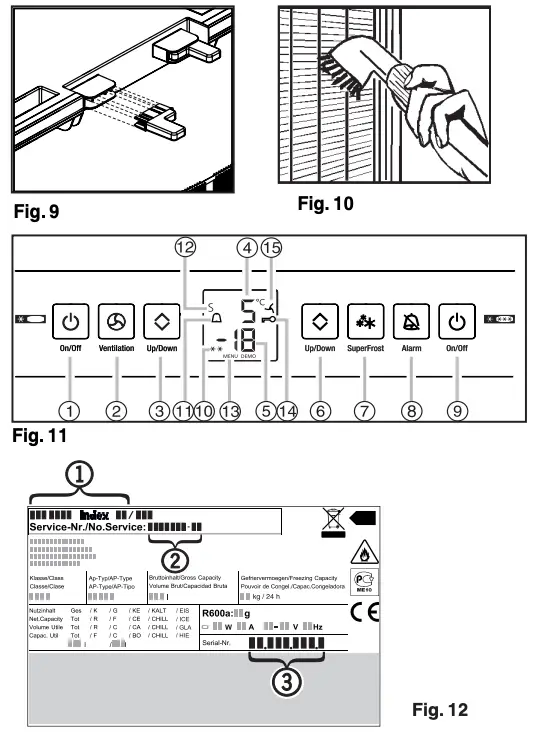


LIEBHERR Fridge Freezer

The manufacturer works constantly on the further development of all the types and models. Therefore please understand that we have to reserve the right to make design, equipment and technical modifications.
To get to know all the benefits of your new appliance, please read the information contained in these instructions carefully.
The instructions apply to several models. Differences may occur. Text relating only to specific appliances is marked with an asterisk (*).
Instructions for action are marked with a , the results of action are marked with a .
Appliance at a glance
Description of appliance and equipment

- Operating and control elements
- Fan
- LED light column
- Shelf
- Shelf, sectioned
- VarioSafe
- Water tank*
- Drain hole
- Coldest zone
- BioCool
- VarioBox
- Can rack
- Bottle rack
- Bottle holder
- LED lighting, freezer compartment
- IceMaker*
- Freezer pack
- Information system
- Freezer compartment drawer
- Soft stop mechanism
- Type plate
Note:
- Place food inside the appliance as shown in the diagram. This allows the appliance to save energy during operation.
- Shelves, drawers and baskets are arranged for optimum energy efficiency on delivery.
Appliance range of use
Intended use
The appliance is only suitable for cooling food products in a domestic or household-like environment. This includes, for example, use: – in staff kitchens, bed and breakfast establishments,
- by guests in country houses, hotels, motels and other accommodation,
- for catering and similar services in the whole-sale trade.
All other types of use are not permitted.
Foreseeable misuse
The following applications are expressly forbidden:
- Storing and refrigerating medicines, blood plasma, laboratory preparations or similar substances and products based on the Medical Device Directive 2007/47/EC
- Use in areas at risk of explosions Misusing the appliance may lead to damage to the goods stored or they may spoil.
Climate classifications
Depending on the climate classification the appliance is designed to operate in restricted ambient temperatures. The climate classification applying to your appliance is printed on the rating plate.
Note: Keep to the specified ambient temperatures in order to guarantee that the appliance works properly.
| Climate classification | for ambient temperatures of |
| SN | 10 °C to 32 °C |
| N | 16 °C to 32 °C |
| ST | 16 °C to 38 °C |
| T | 16 °C to 43 °C |
Conformity
The refrigerant circuit has been tested for leaks. In installed condition, this appliance complies with the applicable safety stipulations and with directives 2014/35/EU, 2014/30/EU, 2009/125/EG, 2011/65/EU and 2010/30/EU.
Product data
Product data is included with the appliance, as per Directive (EU) 2017/1369. The complete product data sheet is available on the Liebherr website under Downloads.
EPREL database
Details about energy labelling and ecodesign requirements will be available on the European product database (EPREL) from 1st March 2021. You can access the product database at the following link: https://eprel.ec.europa.eu/ You will be asked to
enter the model ID. You can find the model ID on the nameplate.
Saving energy
- Pay attention to good ventilation. Do not cover ventilation holes or grids.
- Always keep the fan air slits clear.
- Do not install the appliance in direct sunlight, next to an oven, radiator or similar.
- Energy consumption is dependent on the installation conditions, e.g. ambient temperature (see 1.2 Appliance range of use) . If the ambient temperature deviates from the standard temperature of 25°C, the energy consumption may differ.
- Open the appliance for as short a time as possible.
- The lower the temperature is set the higher the energy consumption.
- Arrange the food in an organised way (see 1 Appliance at a glance) .
- Keep all food properly packed and covered. This prevents frost from forming.
- Only take food out for as long as necessary so that it doesn’t warm up too much.
- Inserting warm food: allow to cool down to room temperature first.
- Thaw frozen food in the refrigerator.
- If you intend to be on holiday for a long time empty the refrigerator and switch it off.
General safety information
Danger for the user:
- This device can be used by children and people with impaired physical, sensory or mental abilities or with a lack of experience and knowledge provided that they are super-vised or have received instruction in the safe use of this device, and about the resulting hazards. Children must not play with this appliance. Cleaning and user maintenance work must not be carried out by children without adult supervision. Children aged between 3 and 8 are allowed to load and unload the appliance.
- Children below the age of 3 must be kept away from the appliance unless they are under continuous adult super-vision.
- When disconnecting the appliance from the supply, always take hold of the plug. Do not pull the cable.
- In the event of a fault pull out the mains plug or deactivate the fuse.
- Do not damage the mains power cable. Do not operate the appliance with a defective mains power cable.
- Repairs, interventions on the appliance and the replacement of mains connection line may only be carried out by After-Sales Service or other suitably trained specialist personnel.
- Only install, connect and dispose of the appliance according to the instructions.
- Only use the appliance when it is installed.
- Please keep these instructions in a safe place and pass them on to any subsequent owners.
Fire hazard:
- The coolant used (information on the model plate) is eco-friendly but also flammable. Any leaking coolant may ignite.
- Do not damage the refrigerant circuit pipes.
- Do not handle ignition sources inside the appliance.
- Do not use electrical appliances inside the appliance (e.g. steam cleaners, heaters, ice cream makers, etc.).
- If the refrigerant leaks: remove any naked flames or ignition sources from the vicinity of the leakage point. Properly air the room. Inform customer services.
- Do not store explosives or sprays using combustible propellants such as butane, propane, pentane, etc. in the appliance. To identify these spray cans, look for the list of contents printed on the can, or a flame symbol. Gases possibly escaping may ignite due to electrical components.
- Please be sure to store alcoholic drinks or other packaging containing alcohol in tightly closed containers. Any alcohol that leaks out may be ignited by electrical components.
Danger of tipping and falling: - Do not misuse the plinth, drawers, doors etc. as a step or for support. This applies particularly to children.
Danger of food poisoning: - Do not consume food which has been stored too long.
Danger of frostbite, numbness and pain: - Avoid prolonged skin contact with cold surfaces or refrigerated/frozen goods or take protective measures, e.g wear use gloves.
Danger of injury and damage: - Hot steam can lead to injury. Do not use electrical heating or steam cleaning equipment, open flames or defrosting sprays to defrost.
- Do not use sharp implements to remove the ice.
Danger of crushing: - Do not hold the hinge when opening and closing the door. Fingers may get caught.
Symbols on the appliance:
- The symbol can be located on the compressor. It refers to the oil in the compressor and indicates the following danger: Swallowing or inhaling can be fatal. This is only relevant for recycling. There is no danger in normal operation.
- This symbol is found on the compressor and indicates the danger of flammable materials. Do not remove the sticker.
- A sticker to this effect may be applied to the rear of the appliance. It refers to the foam-padded panels in the door and/or the housing. This is only relevant for recycling. Do not remove the sticker.
Please observe the specific information in the other sections:
| DANGER | identifies a situation involving direct danger which, if not obviated, may result in death or severe bodily injury. | |
| WARNING | identifies a dangerous situation which, if not obviated, may result in death or severe bodily injury. | |
| CAUTION | identifies a dangerous situation which, if not obviated, may result in minor or medium bodily injury. | |
| NOTICE | identifies a dangerous situation which, if not obviated, may result in damage to property. | |
| Note | It contains useful instructions and tips. |
Controls and displays
Operating and control elements
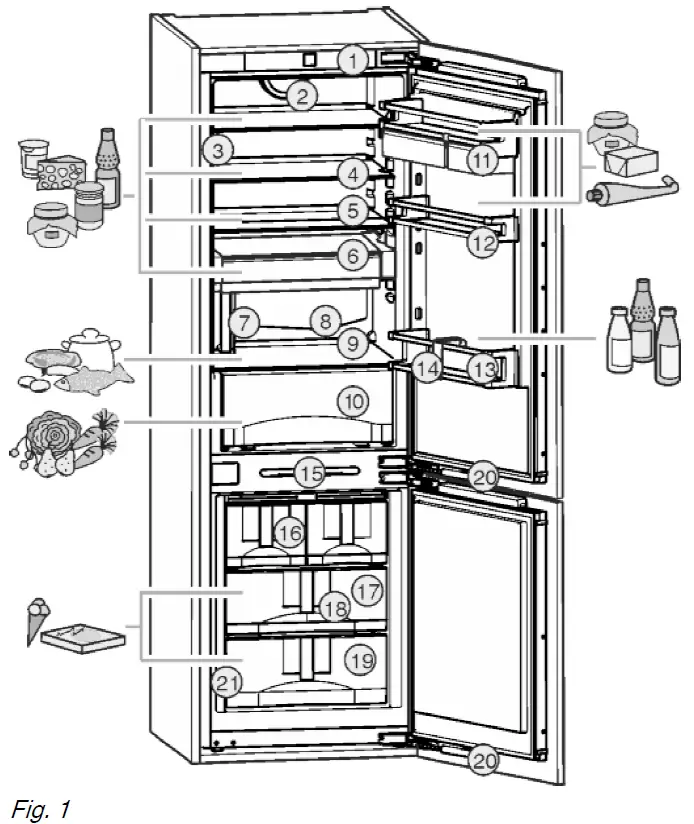
- Refrigerator compartment On/Off button
- Refrigerator compartment temperature display
- Refrigerator compartment Up setting button
- Refrigerator compartment Down setting button
- Ventilation button*
- Ventilation symbol*
- SuperCool button
- SuperCool symbol
- Refrigerator compartment On/Off button
- Freezer compartment temperature display
- Freezer compartment Up setting button
- Freezer compartment Down setting button
- SuperFrost button
- SuperFrost symbol
- Alarm button
- Alarm symbol
- Menu symbol
- Child lock symbol
- IceMaker symbol*
- Water tank symbol*
- Power failure symbol
Temperature display
During normal operation, the display shows:
- the highest freezing temperature
- the average cooling temperature
The freezer temperature display flashes if/when: - You change the temperature setting
- The appliance is not cold enough after switching on
- The temperature rises by several degrees Stripes flash in the display if/when:
- The freezer temperature exceeds 0 °C.
Putting into operation
Switching on the appliance
Note: The manufacturer recommends: Store frozen produce at -18 °C or colder.
Switch on the appliance approx. 2 hours before loading for the first time.
Switching on the entire appliance at the freezer compartment
- Open the door.
- Press On/Off button, freezer compartment Fig. 2 (9) .
- The temperature display of the refrigerator compartment indicates the current temperature inside.
- The temperature display of the freezer compartment and the alarm symbol flash until the temperature is sufficiently low. If the temperature is above 0 °C, dashes flash. If it is below, the current temperature flashes.
- If “DEMO” is displayed, demo mode is activated. Please contact the after sales service.
Switching on the refrigerator compartment
Note: Before going on holiday, or other prolonged periods of non-use
- You can switch the fridge section on/off separately from the freezer section.
- Open the door.
- Press On/Off button, refrigerator compartment Fig. 2 (1) .
- The fridge section is on: Fridge temperature display Fig. 2 (2) is on. When you open the door the interior light comes on.
Control
Child proofing
The child-proofing function enables you to make sure that the appliance is not inadvertently switched off by playing children.
Setting the child lock function
- To activate the setting mode: press SuperFrost button Fig. 2 (13) for about 5 s.
- c flashes on the display.
- The menu symbol Fig. 2 (17) shines.
- Briefly press the SuperFrost button Fig. 2 (13) .to confirm. When c1 is indicated in the display:
- T to activate the child lock, briefly press the SuperFrost button Fig. 2 (13) .
- The child lock symbol Fig. 2 (18) shines. c flashes in the display.
When c0 is indicated in the display:
- to deactivate the child lock, briefly press the SuperFrost button Fig. 2 (13) .
- The child lock symbol Fig. 2 (18) goes out. c flashes in the display.
- To deactivate the set-up mode: press On/Off button, freezer compartment Fig. 2 (9) .
or - Wait for 5 minutes.
- The temperature is indicated again in the temperature display.
Door alarm
For the fridge and freezer compartments
An audible warning sounds if the door is open for longer than 60 seconds.
The audible warning stops automatically when the door is closed.
Muting the door alarm
The audible alarm can be muted when the door is open. The sound switch-off function is active as long as the door is left open.
- Press alarm button Fig. 2 (15) .
- The door alarm is silenced.
Temperature alarm
The audible alarm sounds if the freezer temperature is not cold enough.
The temperature display and the alarm symbol Fig. 2 (16) flash at the same time.
The cause of the temperature being too high may be:
- warm fresh food was placed inside
- too much warm ambient air flowed in when rearranging and removing food
- Prolonged power outage
- the appliance is faulty
The audible alarm is automatically silenced, the alarm symbol Fig. 2 (16) goes out and the temperature display stops flashing when the temperature is sufficiently cold again.
If the alarm status persists: (see 7 Malfunctions) .
Note: Food may be spoilt if the temperature is not cold enough.
Check the quality of the food. Do not consume spoiled food.
Muting the temperature alarm
The audible alarm can be muted. When the temperature is sufficiently cold again, the alarm function is active again.
- Press alarm button Fig. 2 (15) .
- The audible alarm is silenced.
Refrigerator compartment
The natural circulation of air in the refrigerator compartment results in zones differing in temperature. It is coldest directly above the vegetable drawers and at the rear wall. It is warmest at the top front of the compartment and in the door.
Refrigerating food
Note: The energy consumption increases and the cooling performance decreases if the ventilation is inadequate.
- Always keep the air slits of the fan free.
- Store perishable foods such as ready-to-eat meals, meat and sausages in the coldest area. Place butter and preserves in the top area and in the door. (see 1 Appliance at a glance)
- Use reuseable plastic, metal, aluminium, glass containers and foil wrap to store food.
- Always store raw meat and fish in clean, sealed containers on the bottom shelf of the refrigerator, to prevent them coming into contact with or dripping onto other foods.
- Foods that easily absorb or give off smell or taste, as well as liquids, should be stored in sealed containers or covered.
- Use the front area of the base shelf only to temporarily set down refrigerated foods, for example while rearranging or sorting the contents. Remember not to leave refrigerated foods here as they could shift to the back or tip over when you close the door.
- Do not pack foods too closely together, as the air needs to circulate.
Setting the temperature
The temperature depends on the following factors:
- the frequency of opening the door
- how long the door is open for
- the room temperature of the installation location
- the type, temperature and quantity of the food
The temperature can be set from 9 °C to 1 °C, the recommended temperature is 5 °C.
- For a higher temperature setting: press Up button, refrigerator compartment Fig. 2 (3) .
- For a lower temperature setting: press Down button, refrigerator compartment Fig. 2 (4) .
- When the button is pressed for the first time, the previously set value is indicated, flashing, in the refrigerator compartment temperature display.
- To change the temperature in 1 °C steps: briefly press the button.
- To change the temperature continuously: hold down the button.
- The value is displayed flashing during the setting operation.
- The actual temperature is displayed about 5 s after the last press of a button. The temperature slowly adjusts to the new value.
SuperCool
SuperCool is for maximum cooling. This option is for very low temperatures:
In the fridge compartment
Use SuperCool to quickly cool large amounts of food.
When SuperCool is activated, the fan* may run. The appliance operates with maximum cooling performance, which means that the noise of the refrigeration unit may be temporarily louder.
The SuperCool function uses slightly more energy.
Switching on SuperCool
- Briefly press SuperCool button Fig. 2 (7) .
- The SuperCool Fig. 2 (8) symbol lights up in the display.
- The cooling temperature drops to the lowest setting.
- SuperCool is on.
- SuperCool turns off automatically. The appliance continues in energy-saving Normal mode.
To prematurely deactivate SuperCool - Briefly press SuperCool button Fig. 2 (7) .
- The SuperCool symbol Fig. 2 (8) goes out in the display.
- SuperCool is deactivated.
Shelves
Moving or removing shelves
The shelves are prevented from being pulled out accidentally by pull out stops.
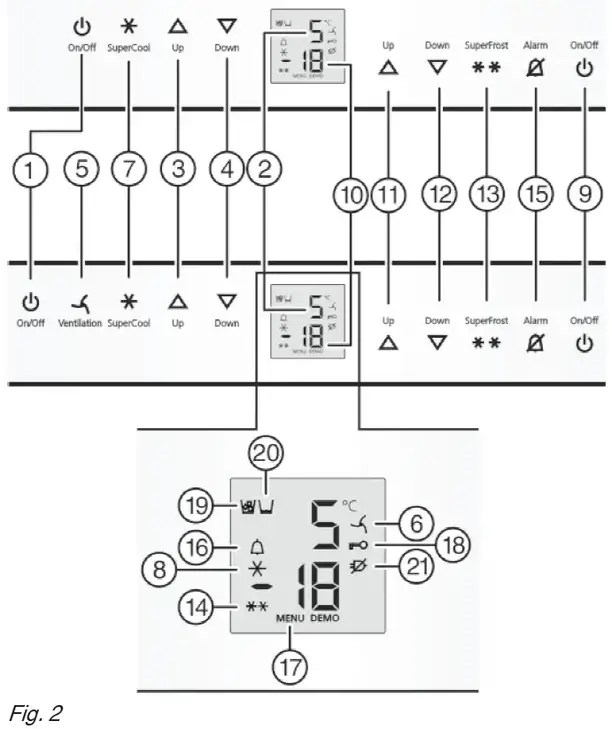
- Lift the shelf and pull forward a little.
- Adjust the height of the shelf. To do this move the slots along the supports.
- In order to remove the shelf fully, place it at a slant and pull out towards the front.
- Insert shelf with the raised edge pointing upwards at the back.
- The food does not freeze onto the rear wall.
Dismantling shelves
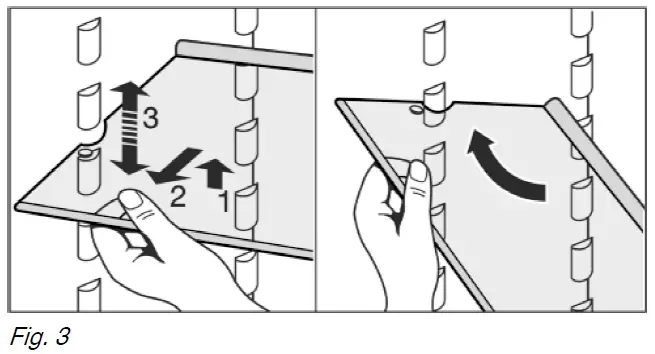
The shelves can be dismantled for cleaning.
Using the sectioned shelf
u Slide the sectioned shelf under, as shown in the illustration.
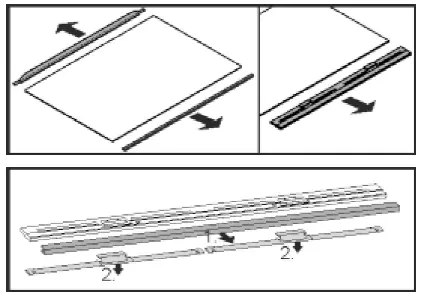
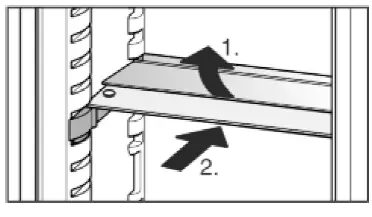
- Attach the support rails, paying attention to the right (R) and left (L) part!
- The glass shelf with stop face (2) has to be at the back.
- The glass plate (1) with pull-out stops must be at the front so that the stops (3) face downwards.
VarioSafe
The VarioSafe provides space for small items of food and packages, tubes and jars.
Using VarioSafe
 The VarioSafe drawer can be taken out and pushed in at two different heights.
The VarioSafe drawer can be taken out and pushed in at two different heights.- The VarioSafe can also be height-adjusted as a whole.
- To remove them completely, set them at an angle and pull towards you.
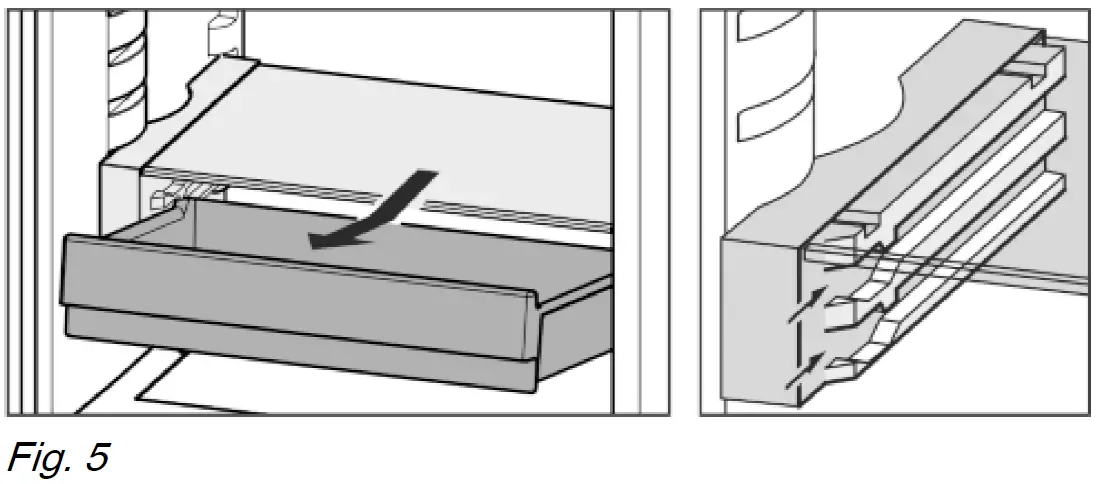
Dismantling VarioSafe
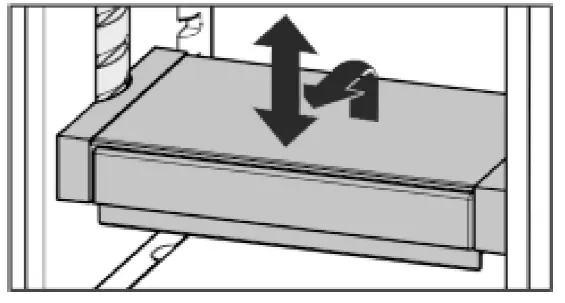
The VarioSafe can be dismantled for cleaning.
Door racks
Moving the storage rack
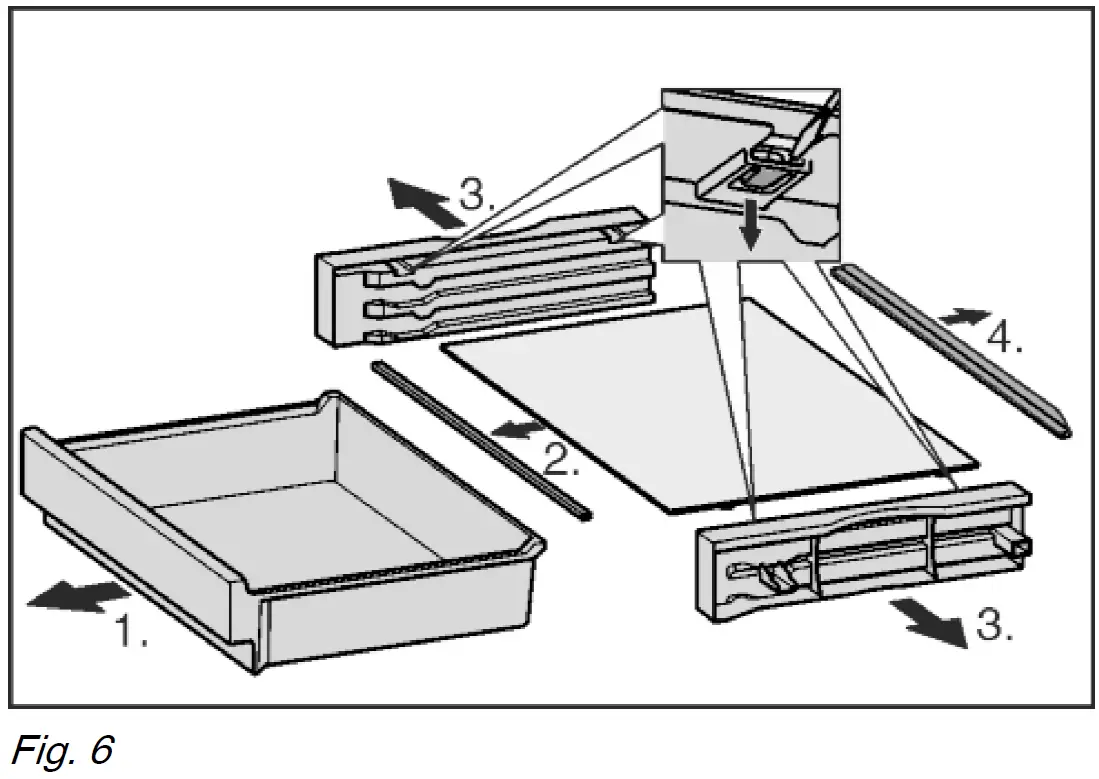

You can use just one or both boxes. To store oversized bottles, just suspend one box over the bottle rack. Store the other box in the holder.
Re-positioning the boxes: Lift them for removal and re-position them as required.

Dismantling door racks
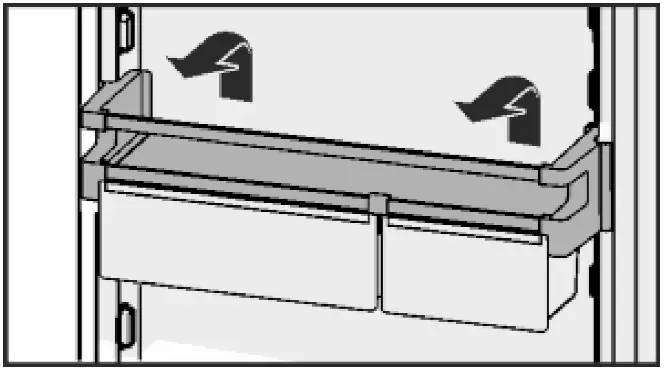
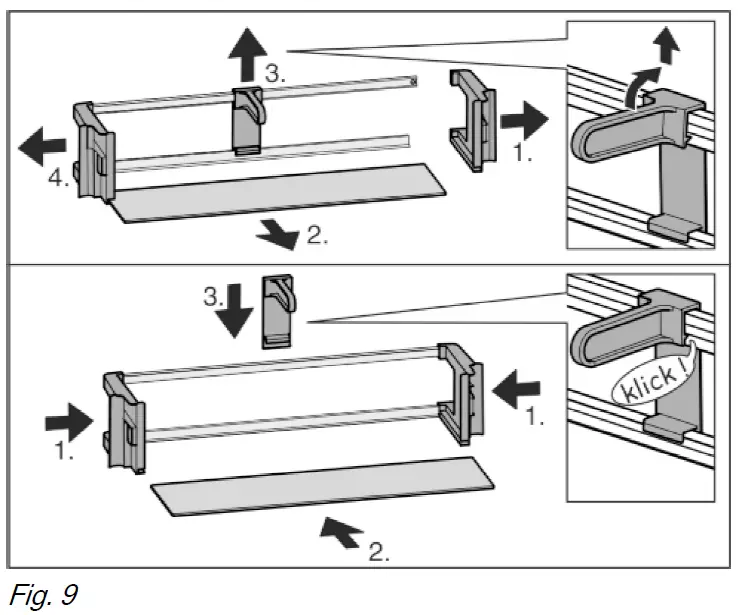
The door racks can be dismantled for cleaning.
Using the bottle holder
To avoid the bottles tipping over, push the bottle holder along.
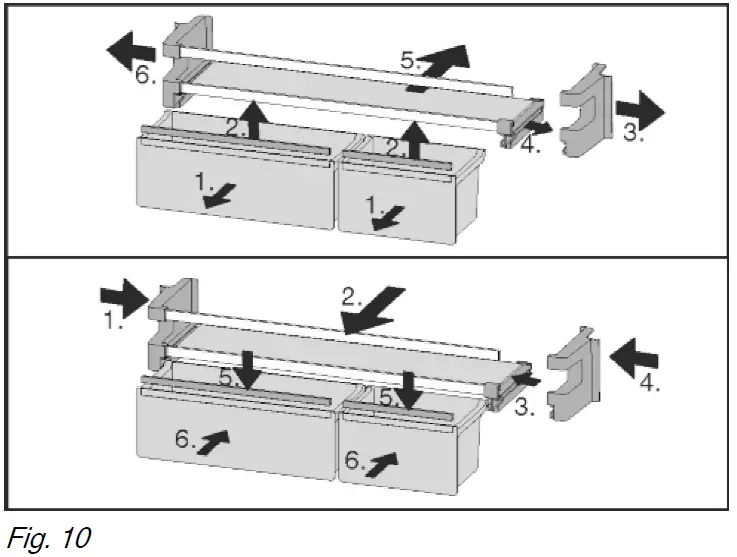
Butter dish
Opening/closing the butter dish
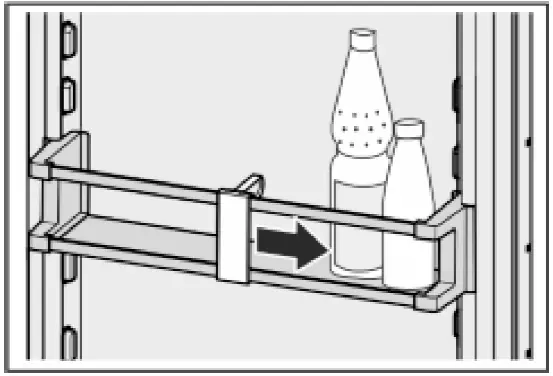
Dismantling the butter dish
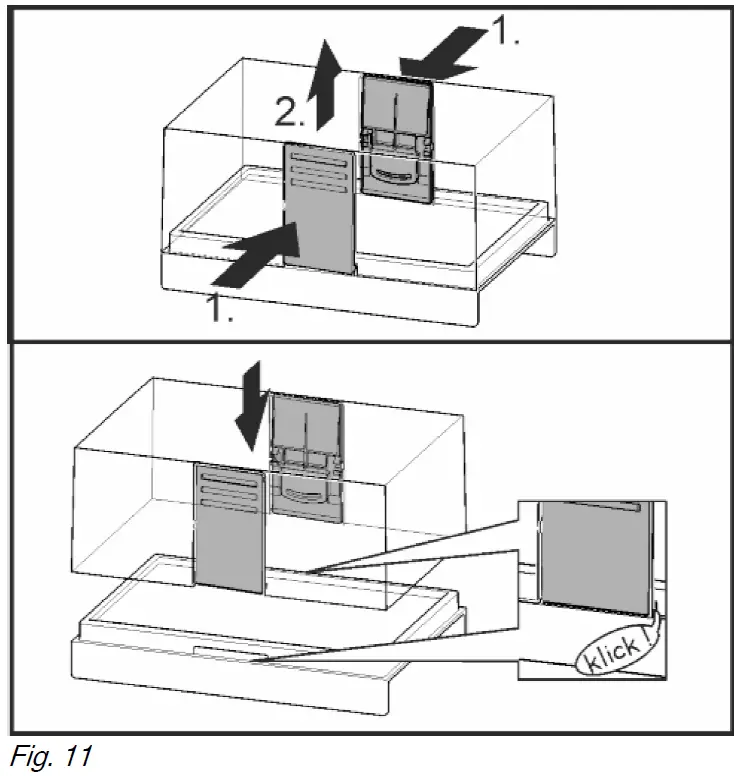
You can take the butter dish apart for cleaning.
Egg tray
You can take out and rotate the egg tray. You can use the two parts of the egg tray to mark different use-by dates, for example.
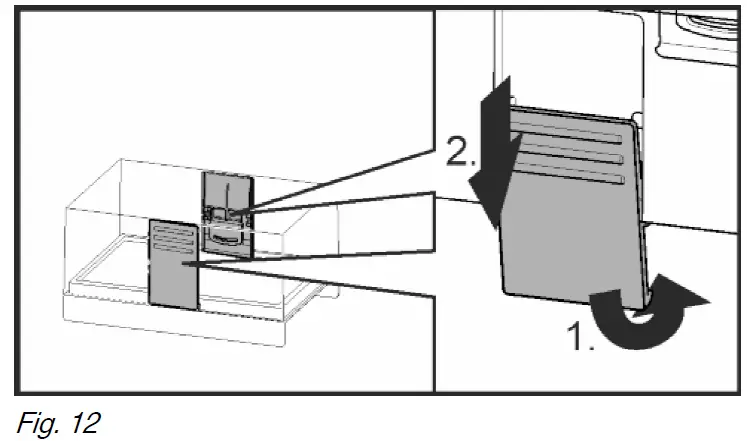
- Use the top part to store e.g. chicken eggs.
- Use the bottom part to store quails’ eggs.
BioCool box
Controlling humidity
Low humidity: Move the slide controller forward.
High humidity:
Move the slide controller back.
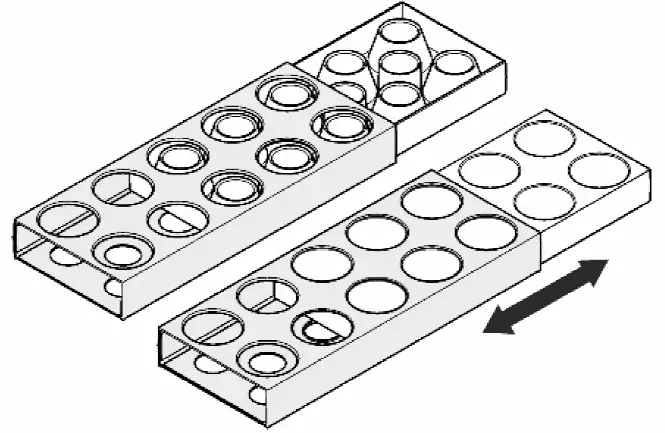
Removing the BioCool box
BioCool box on extendible rails:
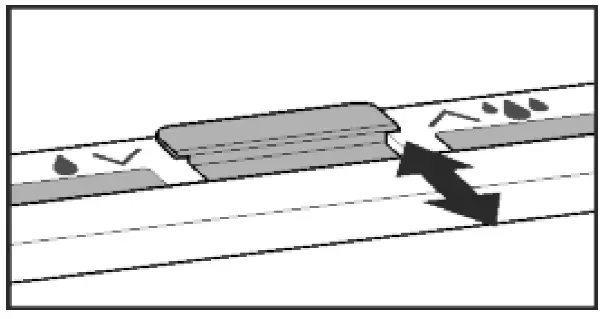
- Pull out the drawer, lift it at the back and remove it from the front.
- Slide the rails in.
- BioCool box can be removed for cleaning.
Freezer compartment
You can store frozen food, make ice cubes and freeze fresh food in the freezer compartment.
Freezing food
The rating plate indicates the maximum quantity of fresh food you can freeze within 24 hours (see 1 Appliance at a glance) under “Freezing capacity … kg/24h”.
Each drawer can hold a max. of 25 kg of frozen food.
The shelves can each be loaded with 35 kg of frozen food.
A vacuum is generated after the door is closed. After closing the door, wait for about 1 minute and then it opens more easily.
CAUTION
Risk of injury due to broken glass!
Bottles and cans containing drinks may burst when being frozen. This applies particularly to sparkling drinks.
- Do not freeze bottles and cans containing drinks!
So that the food is rapidly frozen through to the core, do not exceed the following quantities per pack - Fruit, vegetables up to 1 kg
- Meat up to 2.5 kg
- Pack the food in portions in freezer bags, reusable plastic, metal or aluminium containers
Thawing food
- in the refrigerator compartment
- in a microwave oven
- in a conventional or fan oven
- at room temperature
- Remove only as much food as is required. Use thawed food as quickly as possible.
- Food once thawed should be re-frozen only in exceptional cases.
Setting the temperature in the freezer compartment
The appliance is pre-set for normal operation.
The temperature can be set between -14 °C and -26 °C, the recommended temperature is -18 °C.
- To set the temperature higher: press Up button, freezer compartment Fig. 2 (11) .
- To set the temperature lower: press Down button, freezer compartment Fig. 2 (12) .
- When the button is pressed the first time, the previous value is indicated in the temperature display of the freezer compartment.
- To change the temperature in 1 °C steps: briefly press the button.
or - To change the temperature continuously: hold down the button.
- The value is displayed flashing during the setting operation.
- The actual temperature is displayed approx. 5 seconds after the button is last pressed. The temperature gradually adjusts to the new value.
SuperFrost
With this function you can freeze fresh food quickly through to the core. The appliance operates with maximum refrigeration. The noise of the refrigeration unit may be temporarily louder as a result.
You can freeze as many kilograms of fresh food within 24 hrs as is indicated on the type plate under “Freezing capacity … kg/ 24hrs”. This maximum freezing quantity can vary depending on model and climate class.
You have to activate SuperFrost in good time, depending on how much fresh food is to be frozen: about 6 hours before placing the food inside in case of small amounts and about 24 hours in advance in case of the maximum amount of food to be frozen.
Wrap produce and spread it out as far as possible. Do not allow produce to be frozen to touch produce that is already frozen to prevent the latter thawing.
You do not have to activate SuperFrost in the following cases:
- when placing frozen food in the freezer
- when freezing up to approx. 2 kg fresh food daily
Freezing with SuperFrost
- Briefly press the SuperFrost button Fig. 2 (13) once.
- The SuperFrost symbol Fig. 2 (14) shines.
- The freezing temperature drops, the appliance operates with the maximum cooling capacity.
For a smaller quantity of produce to be frozen: - wait approx. 6 h.
- Place wrapped produce in the top drawers.
For the maximum quantity of produce to be frozen: - wait approx. 24 h.
- Remove top drawers and place produce directly on the top shelves.
- SuperFrost is automatically deactivated. Depending on the quantity placed inside, after 30 h at the earliest, 65 h at the latest.
- The SuperFrost symbol Fig. 2 (14) extinguishes once freezing is completed.
- Place produce in the drawers and push the latter back in again.
- The appliance continues to operate in the energy-saving, normal mode.
Drawers
Note: The energy consumption increases and the cooling performance decreases if there is insufficient ventilation.
For appliances with NoFrost:
- Leave the bottom drawer in the appliance!
- Always keep the air slits of the fan free at the rear wall!
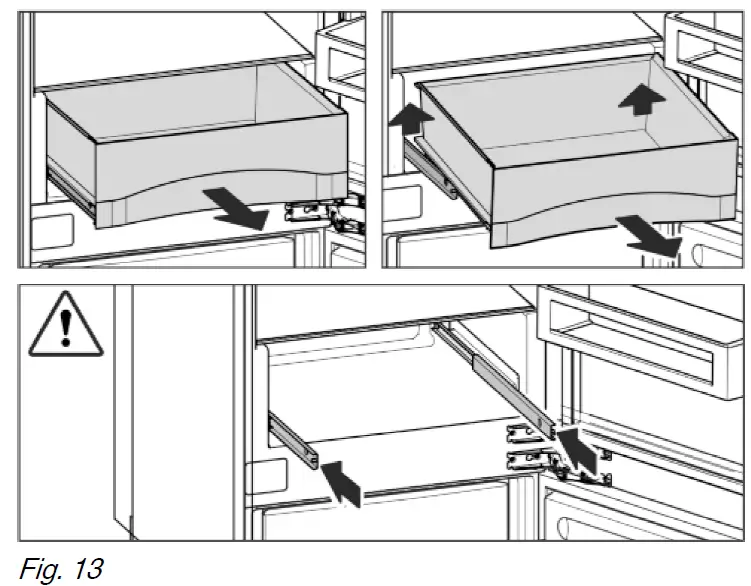
- To store frozen food directly on the shelves pull the drawer forward and lift it out.
Shelves
Moving shelves
- To remove the shelf: lift up at the front and pull out.
- To put the shelf back: simply push in as far as it will go.
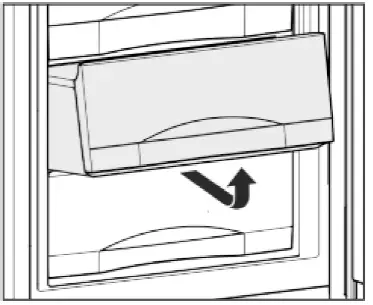
Removing shelves
The shelves may be removed for cleaning.
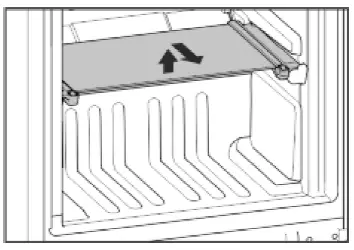
VarioSpace
You can remove the shelves and drawers. This leaves more room for larger food items such as poultry, meat, large game and tall baked goods, which can be frozen whole before further preparation.
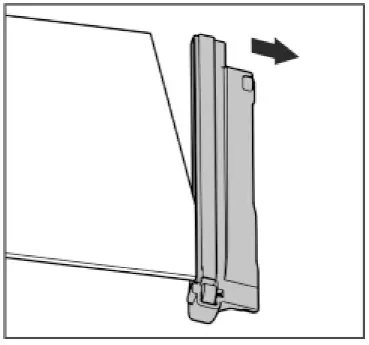
- Each drawer can hold max. 25 kg of frozen food.
- The shelves can each be loaded with 35 kg of frozen food.
Information system
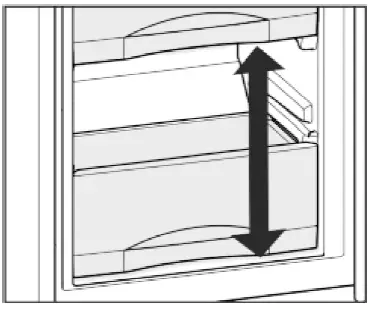
- Bread
- Ice cream
- Fish
- Vegetables
- Meat
- Fruit
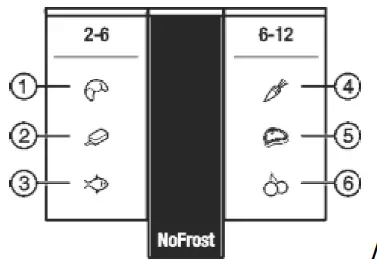
Ice cubes*
The figures indicate the storage time in months for several types of frozen food in each case. Storage times given are guide times.
Ice cube tray
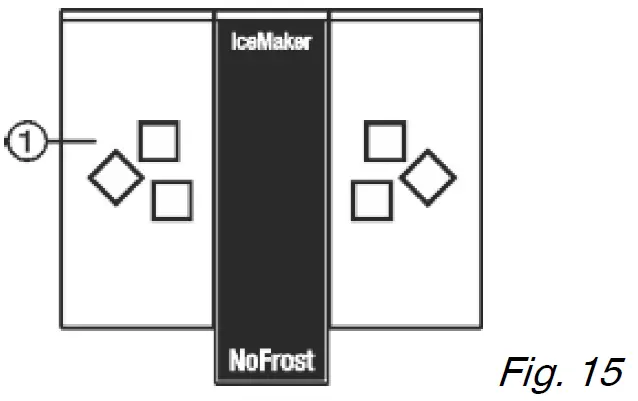
- Hold ice cube tray under hot water for a short time.
- Remove the lid.
- Gently turn the ends of the ice cube tray in opposite directions and release the cubes.
Dismantling the ice cube tray

You can take the ice cube tray apart for cleaning.
Freezer pack
Freezer packs prevent the temperature rising too quickly should there be a power cut.
Using freezer packs
Put the fully frozen freezer packs on the frozen food in the top front section of the freezer compartment.
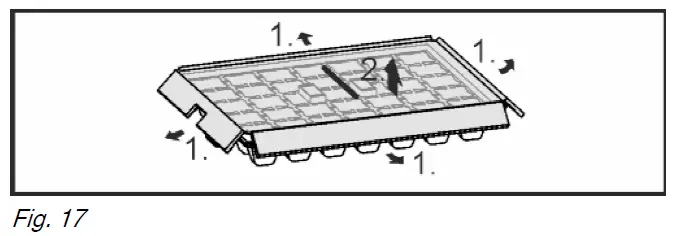
IceMaker*
The IceMaker produces ice cubes using the water container located in the refrigerator compartment. The water container can also be used to provide chilled drinking water.
The IceMaker is in the top drawer of the freezer compartment. The drawer is marked “IceMaker”.
Make certain that the following conditions are met:
- The appliance is level.
- The appliance is connected.
- The freezer compartment is switched on.
- The water tank was cleaned with water and is filled.
Switching on the IceMaker*
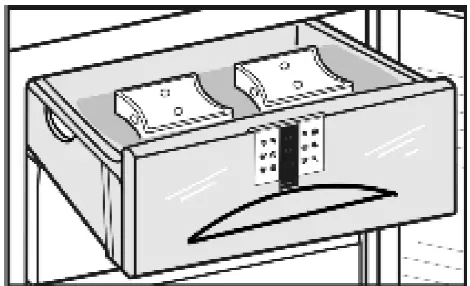
- Pull out the drawer.
- Press the On/Off button Fig. 18 (1) so that the LED Fig. 18 (2) shines.
- Push in the drawer.
- The IceMaker symbol Fig. 2 (19) shines.
Maintenance
NOTICE:
Risk of damage to the IceMaker!
Liquids containing sugar, such as soft drinks, fruit juices or similar, gum up the pump and therefore lead to total pump failure and, as a consequence, to damage to the IceMaker.
Fill the water tank with cold drinking water only! Do not use liquids containing sugar, such as soft drinks, fruit juices or similar!
Note:
Through the use of filtered, decarbonised water, drinking water with the best possible flavour is achieved, and this can be used for problem-free production of ice cubes.
This water quality can be achieved using a table water filter of the kind available in trade retail outlets.
The IceMaker is supplied with water from a water tank in the refrigerator compartment (see 1 Appliance at a glance) .
When the water tank is empty, the water tank symbol Fig. 2 (20) shines.
Before initial operation:
clean the water tank thoroughly with water to remove any dust etc.
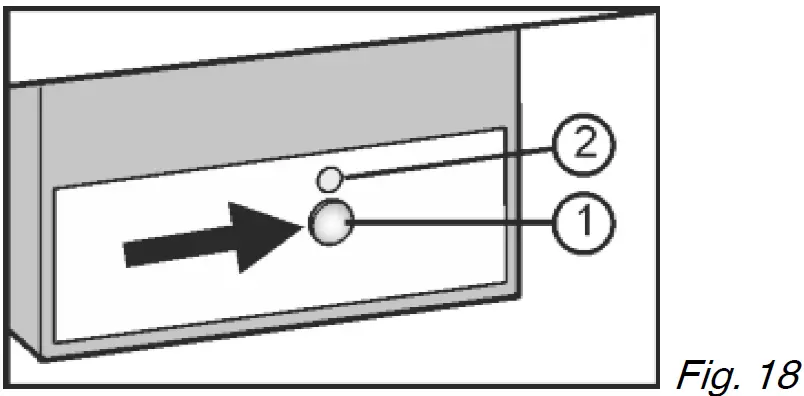
- Pull the water tank forwards.
- Remove cover and fill tank with water.
- Replace the lid, put the filled water tank back into the holder and push it right to the back.
Defrosting with NoFrost
The NoFrost system automatically defrosts the appliance. Refrigerator compartment:
The defrost water evaporates due to the compressor heat. Drops of water on the rear wall are perfectly normal.
Freezer compartment:
The moisture condenses on the evaporator, is periodically defrosted and evaporates.
Cleaning the appliance
Clean the appliance regularly.
WARNING:
Risk of injury and damage as a result of hot steam!
Hot steam can lead to burns and can damage the surfaces.
NOTICE:
Incorrect cleaning damages the appliance!
- Do not use cleaning agents in concentrated form.
- Do not use any scouring or abrasive sponges or steel wool.
- Do not use any sharp or abrasive cleaning agents, nor any that contain sand, chloride or acid.
- Do not use chemical solvents.
- Do not damage or remove the type plate on the inside of the appliance. It is important for the customer service.
- Do not pull off, bend or damage cables or other components.
- Do not allow any cleaning water to enter the drain channel, ventilation grille or electrical parts.
- Please use soft cleaning cloths and a universal pH-neutral cleaning agent.
- Please use cleaning and care products suitable for contact with foodstuffs in the appliance interior.
- Empty appliance.
- Pull out the power plug.
- Clean plastic outer and inner surfaces with lukewarm water and a little washing-up liquid.
- Clean drain hole: Remove deposits with a narrow instrument, e.g. a cotton bud.
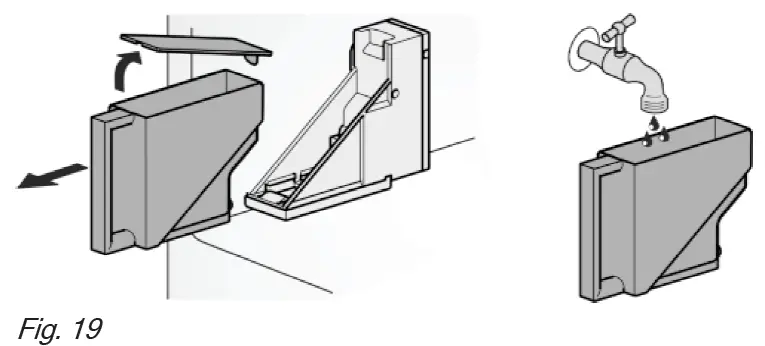
- Empty water collect tray: remove water tank. Carefully unlatch tray at front and then remove from below.*
- Clean the water container by hand using lukewarm water and a small amount of dish washing liquid.*
- The water container and cover are dishwasher safe up to max. 60° *
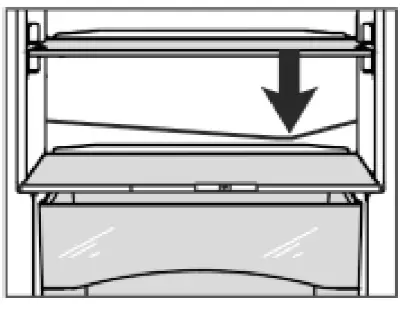
- Most of the parts can be dismantled for cleaning: see the relevant chapter.
- Clean drawers by hand with lukewarm water and a little washing up liquid.
- All the other fittings can be put in the dishwasher.
- Only use a damp cloth to clean the telescopic rails. The grease in the runners is for lubrication purposes and must not be removed.
Note: Clean water reservoir when not in use for more than 24 h.*
After cleaning:
- Wipe dry the appliance and items of equipment.
- Connect the appliance and switch it on again.
- Switch on SuperFrost (see 5.5.4 SuperFrost) . When the temperature is sufficiently cold:
- Put the food back inside.
Disposing of the appliance
The appliance contains some reusable materials and should be disposed of properly – not simply with unsorted household refuse. Appliances which are no longer needed must be disposed of in a professional and appropriate way, in accordance with the current local regulations and laws.
When disposing of the appliance, ensure that the refrigeration circuit is not damaged to prevent uncontrolled escape of the refrigerant it contains (data on type plate) and oil.
- Disable the appliance.
- Pull out the plug.
- Cut through the connecting cable.
Liebherr-Hausgeräte Ochsenhausen GmbH Memminger Straße 77-79
88416 Ochsenhausen
Deutschland
home.liebherr.com
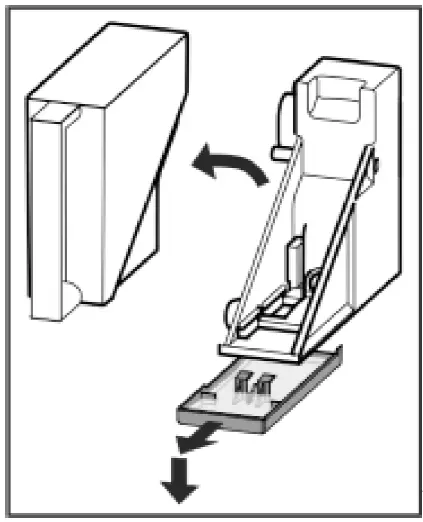

LIEBHERR Refrigerator
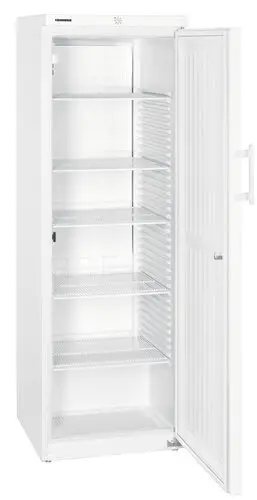
Disposal notes
The appliance contains reusable materials and should be disposed of properly – not simply with unsorted household refuse. Appliances which are no longer needed must be disposed of in a professional and appropriate way, in accordance with the current local regulations and laws.
When disposing of the appliance, ensure that the refrigerant circuit is not damaged to prevent uncontrolled escape of the refrigerant it contains (data on type plate) and oil.
- Disable the appliance.
- Pull out the mains plug.
- Cut through the connection cable.
Danger of suffocation due to packing material and plastic film!Do not allow children to play with packaging material. Take the packaging material to an official collection point.
Range of appliance use
The appliance is suitable solely for cooling food in a domestic environment or similar. This includes, for example, use
- in staff kitchenettes, bed and breakfast establishments,
- by guests in cottages, hotels, motels and other forms of accommodation,
- in catering and similar services in the wholesale trade.
Use the appliance solely as is customary within a domestic environment. All other types of use are inadmissible. The appliance is not suitable for storing and cooling medicines, blood plasma, laboratory preparations or similar substances and products covered by the 2007/47/EC Medical Devices Directive. Any misuse
of the appliance may result in damage to or spoilage of stored goods. Furthermore, the appliance is not suitable for operation in potentially explosive atmospheres.
Description of the appliance
Safety instructions and warnings
- To prevent injury or damage to the unit, the appliance should be unpacked and set up by two people.
- In the event that the appliance is damaged on delivery, contact the supplier immediately before connecting to the mains.
- To guarantee safe operation, ensure that the appliance is set up and connected as described in these operating instructions.
- Disconnect the appliance from the mains if any fault occurs. Pull out the plug, switch off or remove the fuse.
- When disconnecting the appliance, pull on the plug, not on the cable.
- Any repairs and work on the appliance should only be carried out by the customer service department, as unauthorised work could prove highly dangerous for the user. The same applies to changing the mains power cable.
- Do not allow naked flames or ignition sources to enter the appliance. When transporting and cleaning the appliance, ensure that the refrigerant circuit is not damaged. In the event of damage, make sure that there are no ignition sources nearby and keep the room well ventilated.
- Do not stand on the plinth, drawers or doors or use them to support anything else.
- This appliance can be used by children of 8 years old and over, and also by persons with restricted physical, sensory or mental capacity or lack of experience and knowledge, if they are supervised or have been instructed on safe use of the appliance and understand the resulting risks. Children must not be allowed to play with the appliance. Cleaning and user maintenance must not be carried out by children without supervision.
- Avoid prolonged skin contact with cold surfaces or chilled/frozen food. This could cause pain, numb-ness and frostbite. In the case of prolonged skin contact, protective measures should be taken,
e. g. gloves should be worn. - Do not consume food which has been stored for too long, as it could cause food poisoning.
- Do not store explosives or sprays using com-bustible propellants such as butane, propane, pentane, etc. in the appliance. Electrical com-ponents might cause leaking gas to ignite. You may identify such sprays by the printed contents or a flame symbol.
- Do not use electrical appliances inside the appliance.
- If you have a lockable appliance, do not keep the key near the appliance or within reach of children.
- The appliance is designed for use in enclosed areas. Do not operate the appliance outdoors or in areas where it is exposed to splash water or damp conditions.
Climate rating
The climate rating indicates the room temperature at which the appliance may be operated in order to achieve full refrigeration performance.
The climate rating is indicated on the type plate.
The position of the type plate is shown in the section entitled
Description of the appliance.
Climate rating Room temperature
4 (SN) +10°C to +32°C
4 (N) +16°C to +32°C
4+ (ST) +16°C to +38°C
4+ (SN-ST) +10°C to +38°C
5 (T) +16°C to +43°C
5 (SN-T) +10°C to +43°C
Setting up
- Do not place the appliance in direct sunlight or near cookers, radiators and similar sources of heat.
- The floor on which the appliance stands should be horizontal and level. Compensate for uneven floors with the adjustable feet.
- Do not cover ventilation openings or grille.
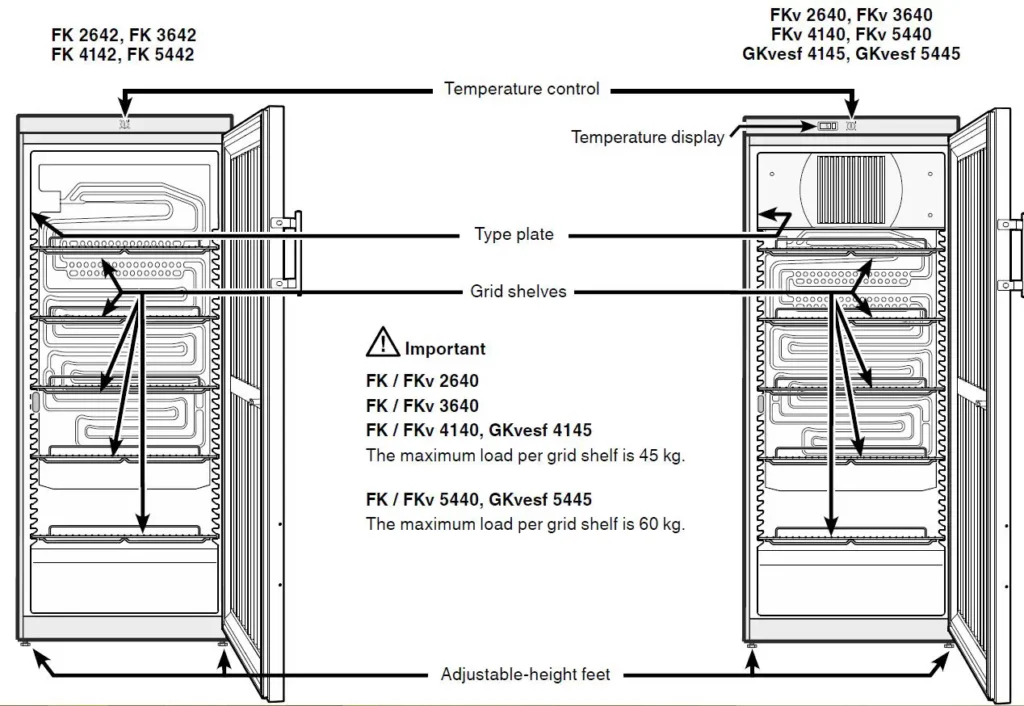
- Standard EN 378 specifies that the room in which you install your appliance must have a volume of 1 m3 per 8 g of R 600a refrigerant used in the appliance, so as to avoid the formation of inflammable gas/air mixtures in the room where the appliance is located in the event of a leak in the refrigerant circuit. The quantity of refrigerant used in your appliance is indicated on the type plate on the inside of the appliance.
- Always install the appliance directly against the wall.
Appliance dimensions (mm)
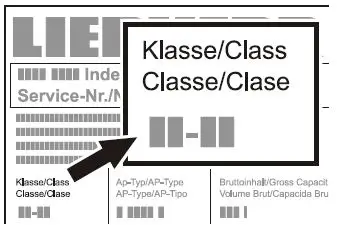
Electrical connection
Only operate the appliance with alternating current (AC). The permissible voltage and frequency are indicated on the type plate. The position of the type plate is shown in the section entitled
Description of the appliance.
The socket must be properly earthed and protected by a fuse. The tripping current of the fuse must be between 10 A and 16 A. The socket must not be situated behind the appliance and must be easily accessible.
Do not connect the appliance using an extension cable or extension socket.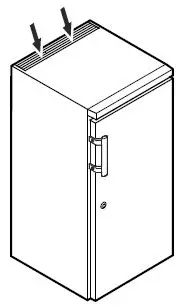
Do not use stand-alone inverters (conversion of direct current to alternating current/three phase current) or energy-saving plugs. Risk of damage to the electronic control system!
Switching the appliance on and off
You are recommended to clean the interior of the appliance before switching it on for the first time (see Cleaning).
Switching the appliance on
Connect the appliance to the mains – the appliance is switched on.
Switching the appliance off
Pull out the mains plug or set the temperature control to 0.
Important
When the temperature control is turned to “0”, the refrigeration system is switched off, but the appliance is not completely disconnected from the mains. Before cleaning, always disconnect the appliance from the mains. Remove the plug
Setting the temperature
Set the temperature inside the appliance using the temperature control.
The nearer the temperature control is to the max. setting, the colder the interior temperature.
Set the control between “0” and “max.” as required.
Temperature display
FKv 2640, 3640, 4140, 5440, GKvesf 4145, 5445
The temperature display is powered by a battery which is available from your specialist dealer.
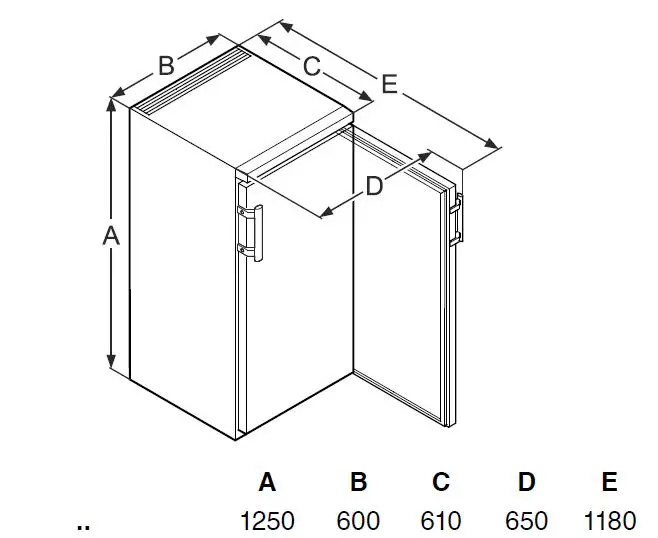
Changing the battery
- Open the battery compartment using a small screwdriver.
- Replace the battery.
- Close the battery compartment.
If Er or HH appears in the display, the appliance has a fault. Consult the customer service department indicating the fault number displayed.
Cooling
The grid shelves can be moved to accommodate different height bottles or packages.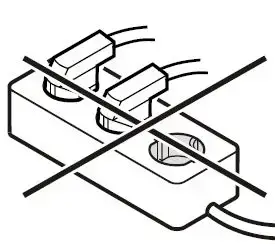
High-percentage alcohols should be tightly sealed and stored upright.
The ventilation slots on the inside must not be covered!
Safety lock
The lock in the appliance door is equipped with a safety mechanism.
Locking the appliance
- Insert the key as shown by arrow 1.
- Turn the key 90°.
- To unlock the appliance, the same procedure must be repeated in the same order.
Defrosting
The refrigerator compartment defrosts automatically.
When operating at a very cold thermostat setting, the interior rear wall may ice up.
In this case, the appliance must be defrosted manually.
- Pull out the mains plug!
- Remove the food from the appliance and store in a cool place.
- Leave the door of the appliance open while defrosting. After defrosting mop up the remaining water and clean the appliance.
Do not use any mechanical devices or other artificial aids for defrosting other than those recommended by the manufacturer.
Cleaning
Clean the appliance at least twice per year.
Before cleaning always switch off the appliance. Pull out the mains plug or switch off or unscrew the fuse.
- Clean the inside, equipment and outer walls with lukewarm water and a little detergent. Do not use abrasive or acid cleaners or chemical solvents.
- Ensure that no cleaning water penetrates into the electrical components or ventilation grille.
- The dust should be removed from the refrigeration unit and heat exchanger – metal grid at the back of the appliance – once a year.
- Do not damage or remove the type plate on the inside of the appliance. It is very important for servicing purposes.
- Do not use steam cleaners because of the risk of injury and damage.
Malfunctions
If a malfunction occurs during operation, check whether it is due to an operating error.
You may be able to rectify the following faults yourself:
- Appliance does not function:
- Is the appliance switched on?
- Is the plug correctly fitted in the mains socket?
- Is the fuse intact?
- Loud running noise:
- Is the appliance set up firmly on the floor?
- Does the appliance cause nearby items of furniture or objects to vibrate? Please note that noises caused by the refrigerant circuit cannot be avoided.
- The temperature is not low enough:
- Is the temperature setting correct (see “Setting the temperature”)?
- Have excessive amounts of fresh food been placed in the appliance?
- Does the separately installed thermometer show the correct reading?
- Is the ventilation system working properly?
- Is the appliance set up too close to a heat source?
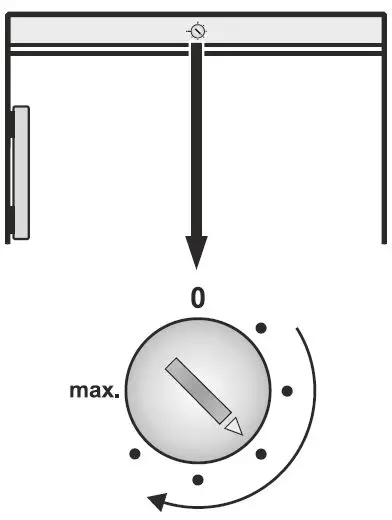
If none of the above causes apply and you cannot rectify the fault yourself, contact the nearest customer service department stating the type designation 1, service number 2 and appliance number 3 as indicated on the type plate.
The position of the type plate is shown in the section entitled Description of the appliance.
Changing over door hinges
Door hinges should only be changed by a trained expert.
Changing the door hinges must be done by two people.
- Remove screw from lower hinge bracket.
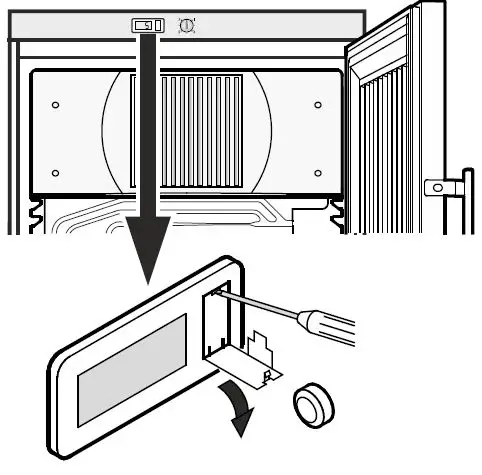
- Open the door approx. 45° and lift upwards.
Important: As a result of its heavy weight, the door must be held secure by one person. - Push the pin upwards using your fingertip.
- Pull the door to the front and remove it downwards.
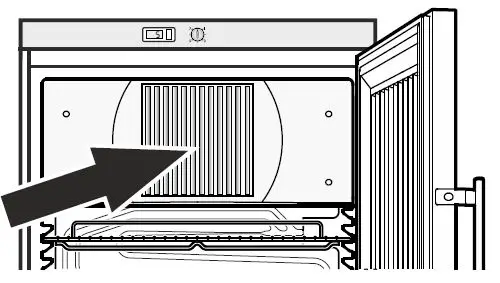
- Transfer door handle and plugs to the other side.
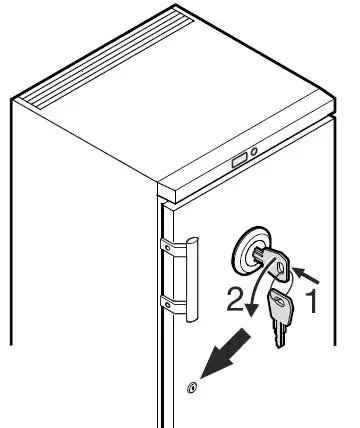
- Unscrew the pin. Use the spanner provided.
- Screw in the pin on the opposite side.
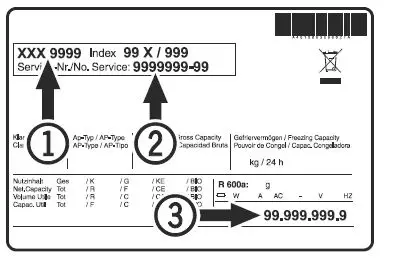
- Transfer locking bracket to the opposite side.
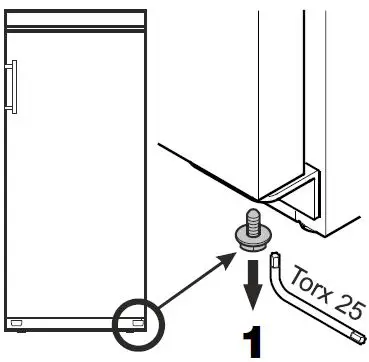
- Unscrew hinge bracket.

- Remote the cover, turn it through 180° and re-fit it on the opposite side.
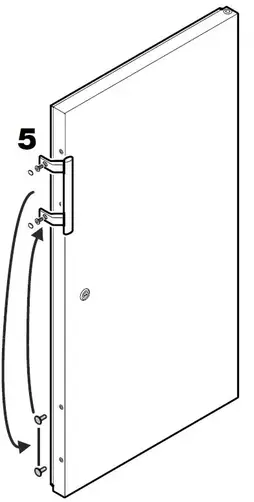
- Screw hinge bracket into place.
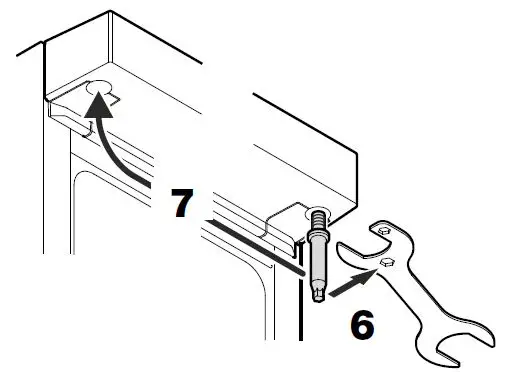
- Turn the door by 180°.
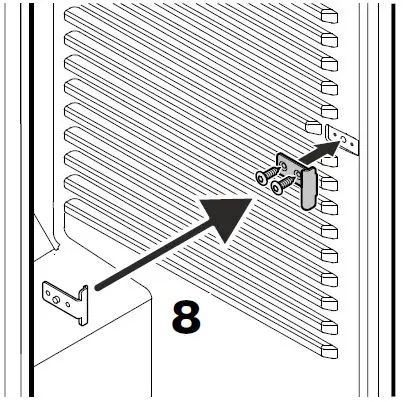
- Insert the pin into the left-hand door mounting.
Use your index finger to hold the pin while you are assembling the door.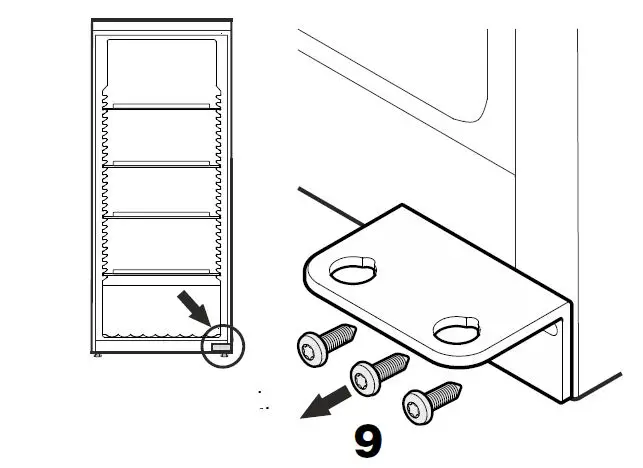
- Locate the door on the upper pin as shown in the illustration and guide it to the lower hinge bracket.
Important: As a result of its heavy weight, the door must be held secure by one person - Lift the door upwards and turn the pin until it fits into the bore hole of the hinge bracket.
Slowly lower the door downwards. The lower part of the pin must be fully engaged in the bore hole of the hinge bracket.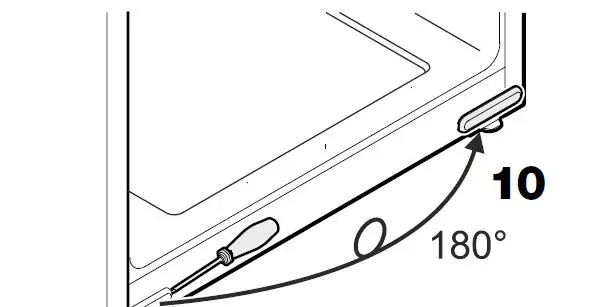
- Screw the screw into the pin again and tighten.
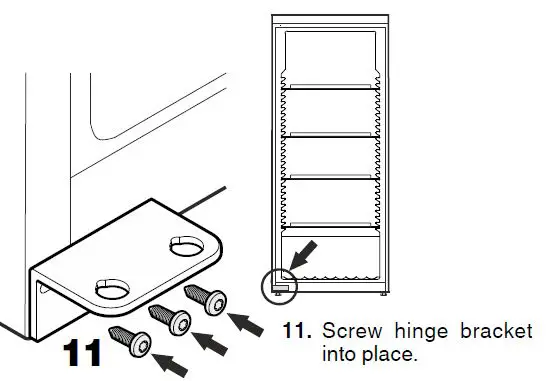
Adjusting the lateral tilt of the door
- Remove middle screw from hinge bracket.
This screw is no longer needed.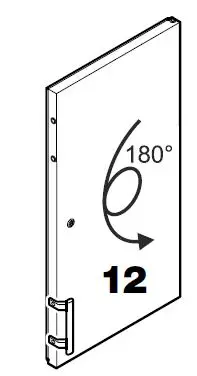
- Undo screws and slide hinge bracket to the right or left. Tighten screws.
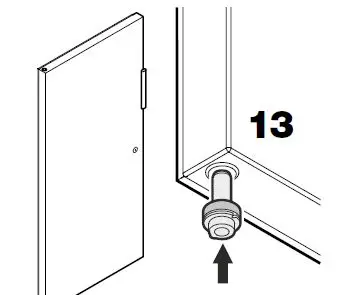


LIEBHERR Compact Under Bench Refrigerator
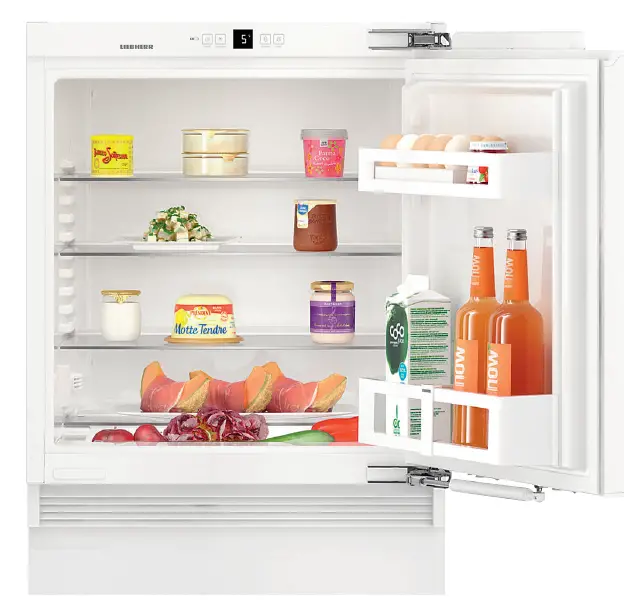
Model: SUIK 1510
| Model | SUIK 1510 |
| Type | UB – FI |
| Finish | Own cabinetry |
| Energy consumption (kWh/yr) I Star rating | 147kWh I 3.5 |
| Compressors | 1 |
| Total capacity litres (L) – Gross I Net | 141 I 135 |
| Refrigerator gross (L) I net (L) | 141 I 135 |
| MagicEye control system I Display | • I LCD |
| Child proof setting for display & temp. | • |
| LED standard lighting | • |
| SoftSystem hinge – assists closure | • |
| 115º door opening | • |
| Refrigerator Features | |
| Fruit & vegetable crisper bin | 1 |
| SuperCool | • |
| GlassLine shelves | • |
| Elegant holding columns | • |
| Bottle shelf I Egg tray | • I • |
| Automatic refrigerator defrosting | • |
| Technical Information | |
| Default hinge | Right |
| Voltage (V) I Rated Current (A) | 220-240 I 1.2 |
| Made in | Germany |
KEY: UB = Underbench, FI = Fully Integrated.
Door hinging either right or left hand must be nominated for this model.
Dimensions

Whilst every effort is made to ensure all specifications and information in this flyer are correct at time of printing, Andi-Co Australia Pty. Ltd. reserve the right to make changes without notification. Where actual appliance measurements, specifications and ratings are crucial, we recommend that the actual appliance installation instructions that accompany each appliance be checked. Andi-Co Australia will not be liable for any loss.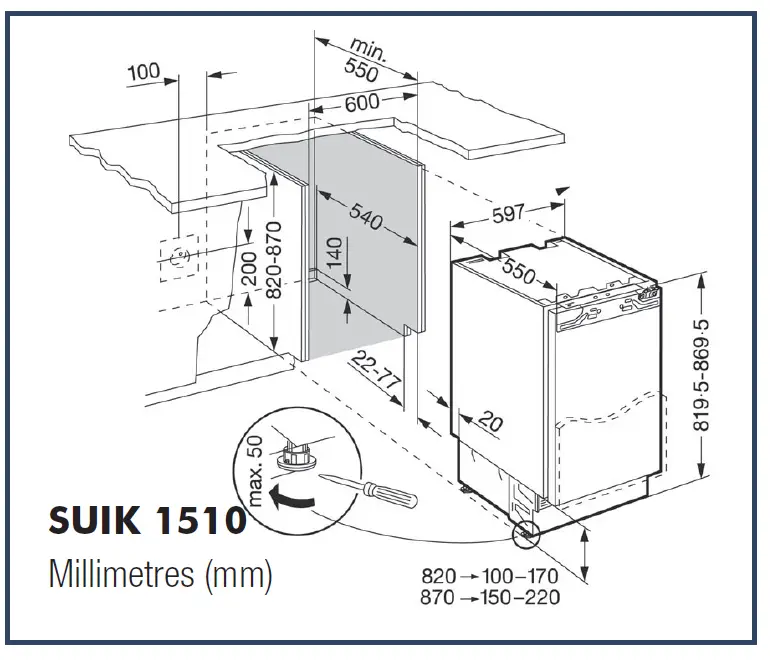
 INTEGRATED APPLIANCES
INTEGRATED APPLIANCESUIG 1313
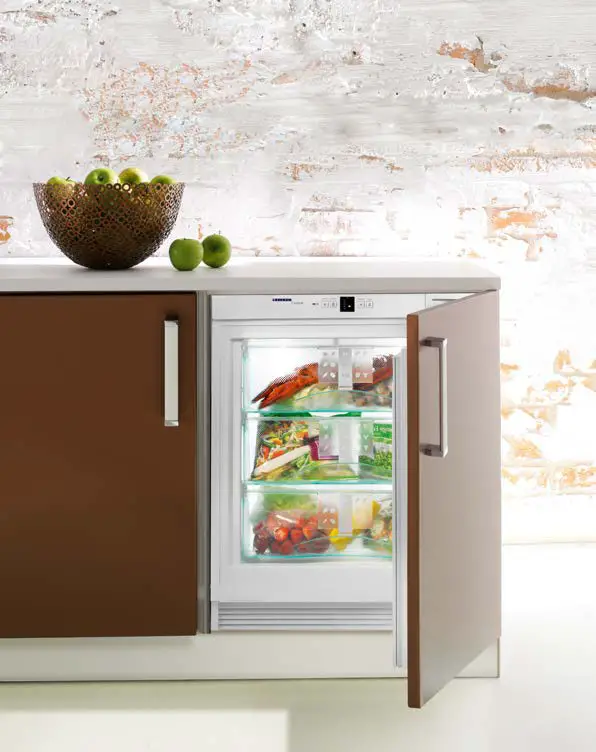
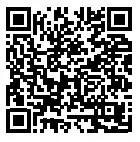
http://www.andico.com.au/liebherr/liebherr-underbench-fridges-uig-1313
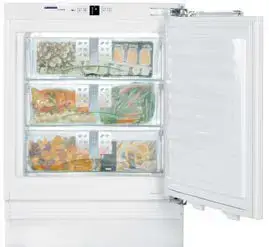
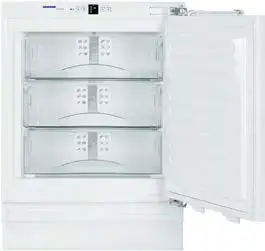
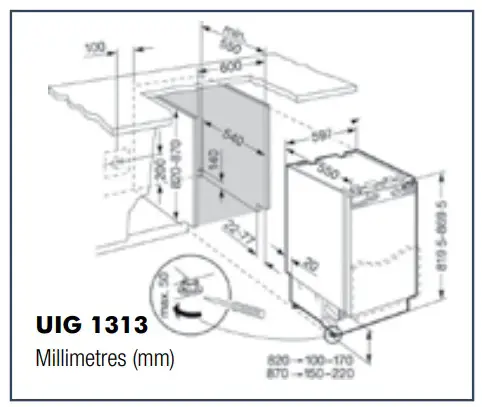
Whilst every effort is made to ensure all specifications and information in this flyer are correct at time of printing, Andi-Co Australia Pty. Ltd. reserve the right to make changes without notification. Where actual appliance measurements, specifications and ratings are crucial, we recommend that the actual appliance installation instructions that accompany each appliance be checked. Andi-Co Australia will not be liable for any loss.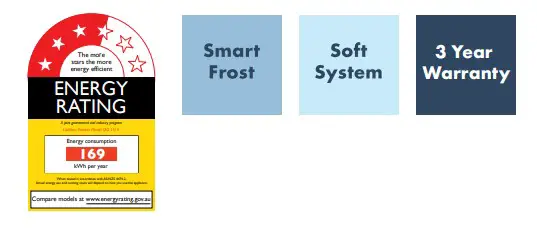
| Model | UIG 1313 |
| Type | U13-F1 |
| Finish | Own cabinetry |
| Energy consumption (kWh/yr)star rating | 169kWh I 3.5 |
| Compressors | 1 |
| Total capacity liters (L) – Gross I Net | 96 195 |
| Freezer gross (L) I net (L) | 96 195 |
| MagicEye control system I Display | I LED |
| The childproof setting for display & temp. | • |
| SoftSystem hinge – assists closure | • |
| 115° door opening | • |
| Temperature alarm | • |
| Malfunction warning signal | • |
Freezer Features
| Freezer defrosting | Manual |
| Transparent drawers | SmartFrost |
| Freezer drawers | 3 |
| SuperFrost | • |
| VarioSpace | • |
| 24hr freezing capacity (kg) | 12 |
| Cold storage accumulators | 2 |
Technical Information
| Default hinge | Right |
| Voltage (V) I Rated Current (A) | 220-240 1.3 |
| Made in | Germany |
KEY: UB = Underbench, FI = Fully Integrated.
Door hinging either right or left hand must be nominated for this model.

HEAD OFFICE: 1 Stamford Road Oakleigh Vic 3166, T: 1800 685 899, E: [email protected], W: www.andico.com.au
LPF140218